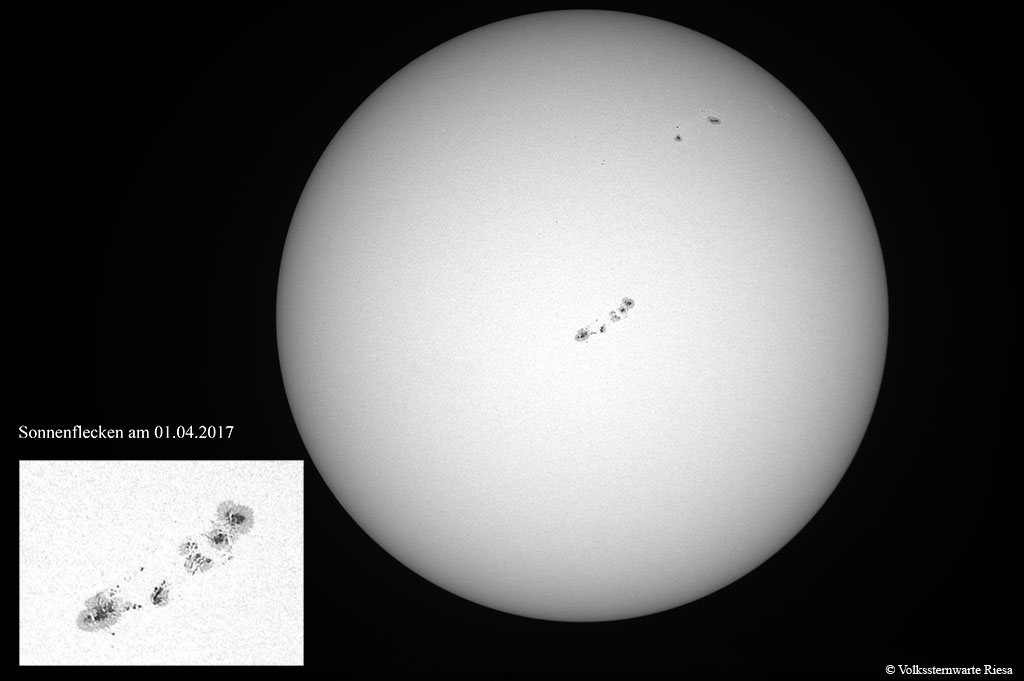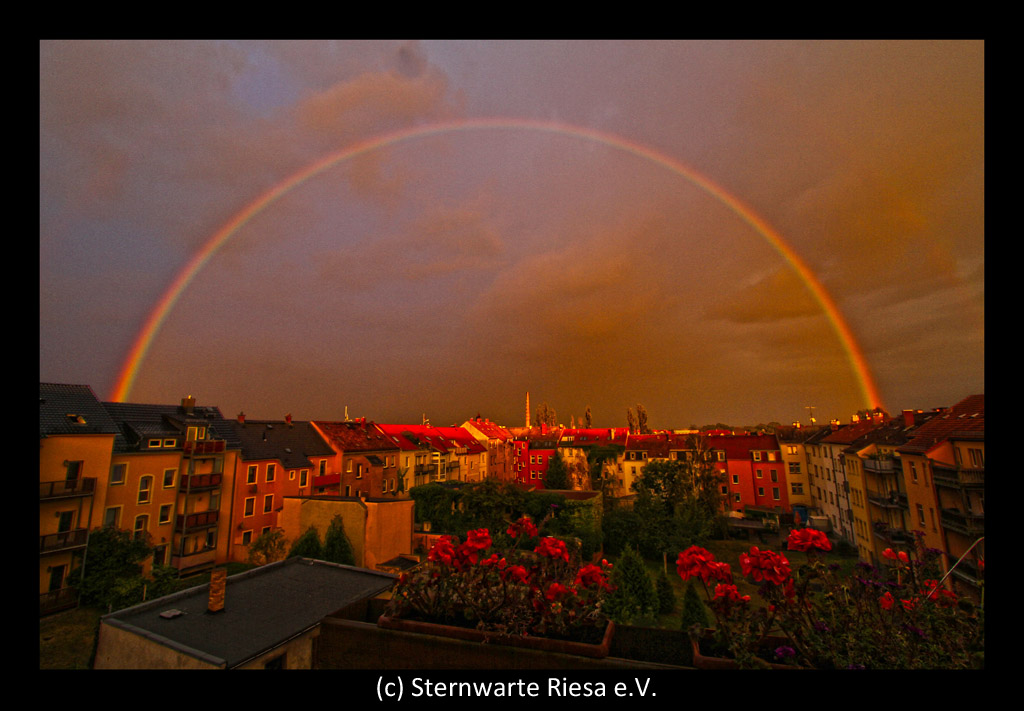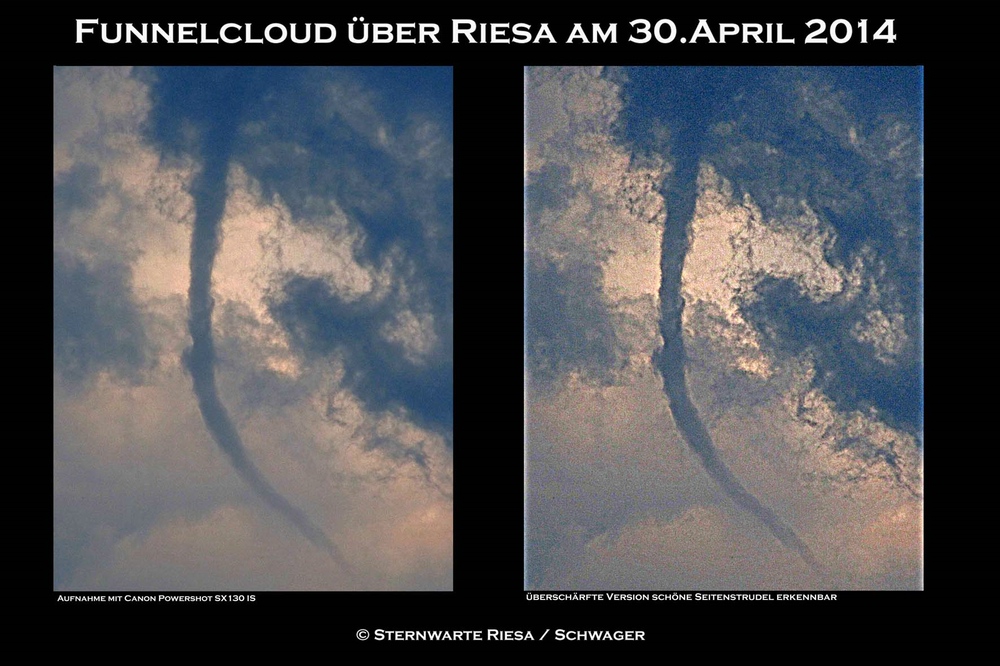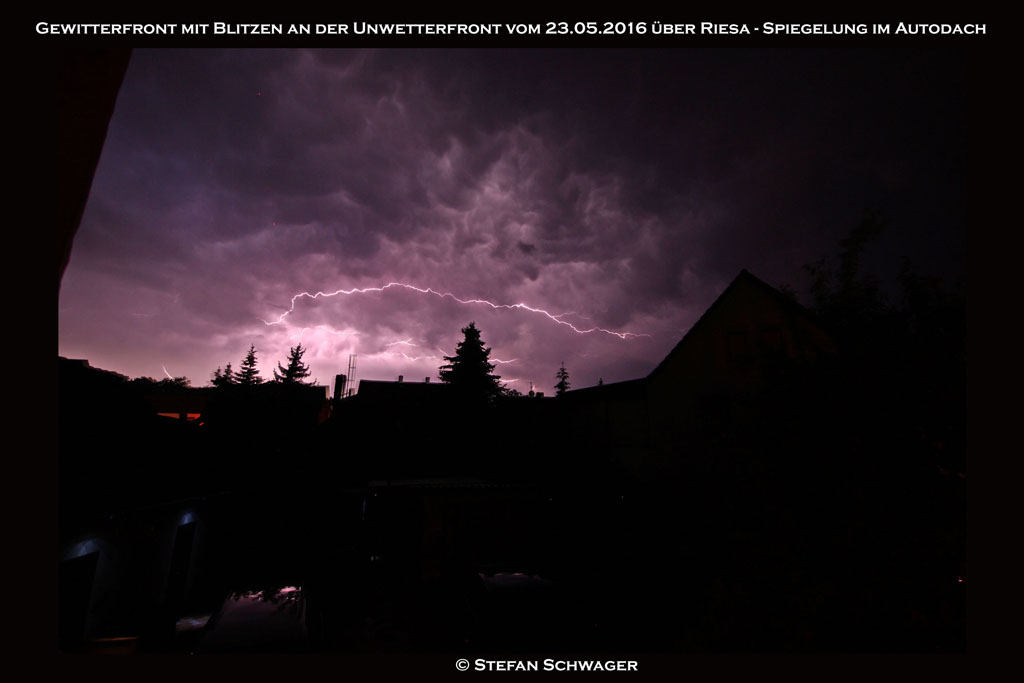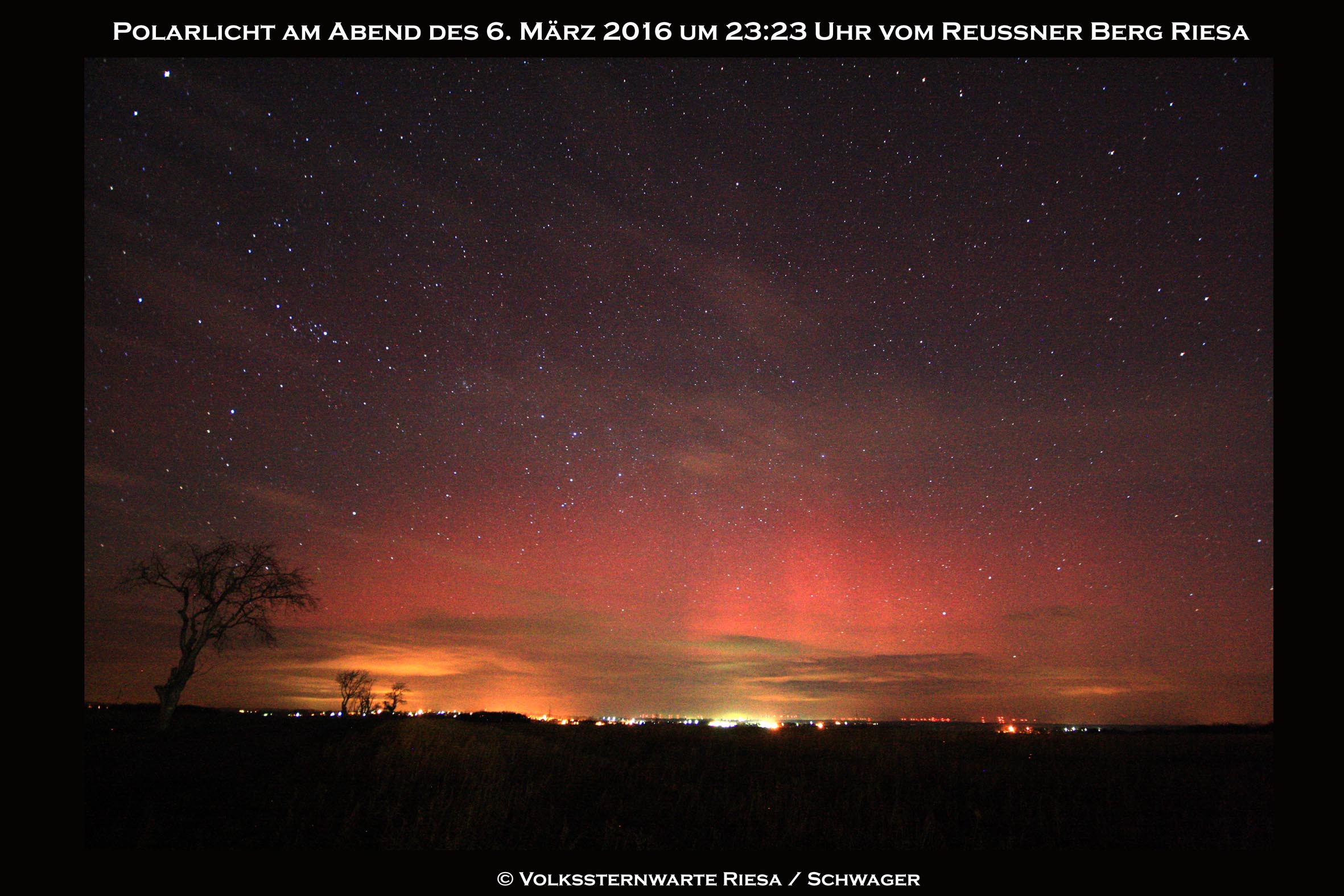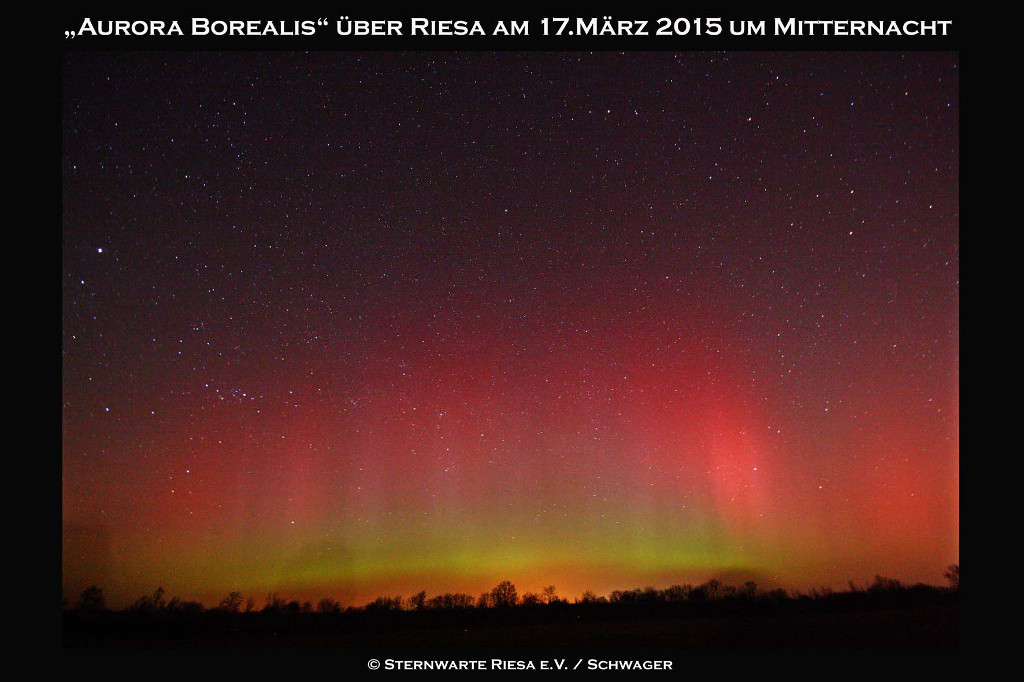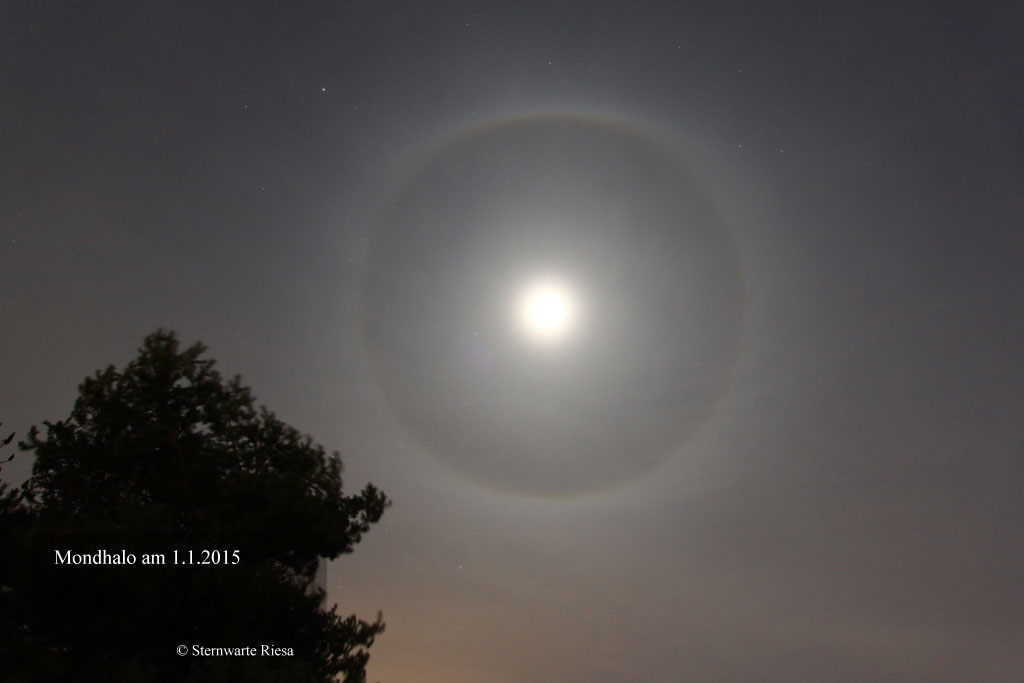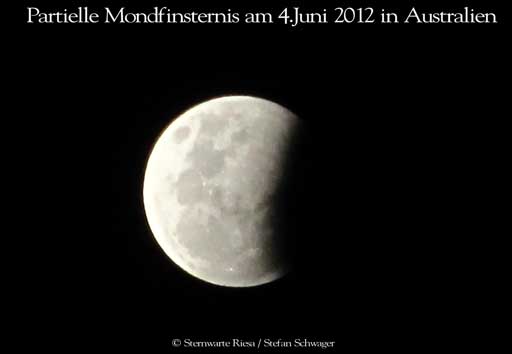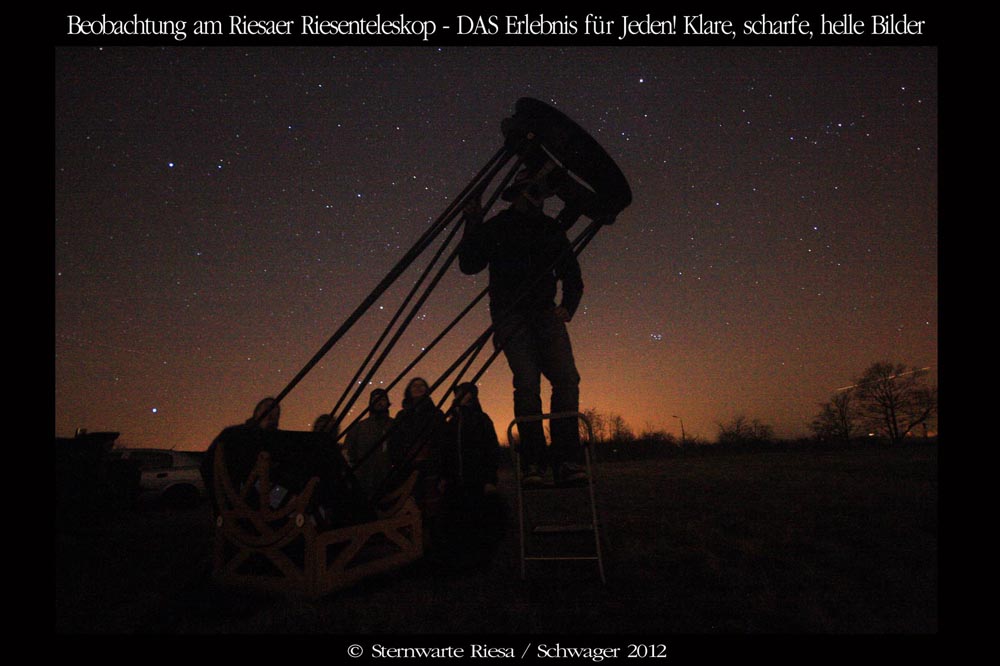12th STT at Peritz
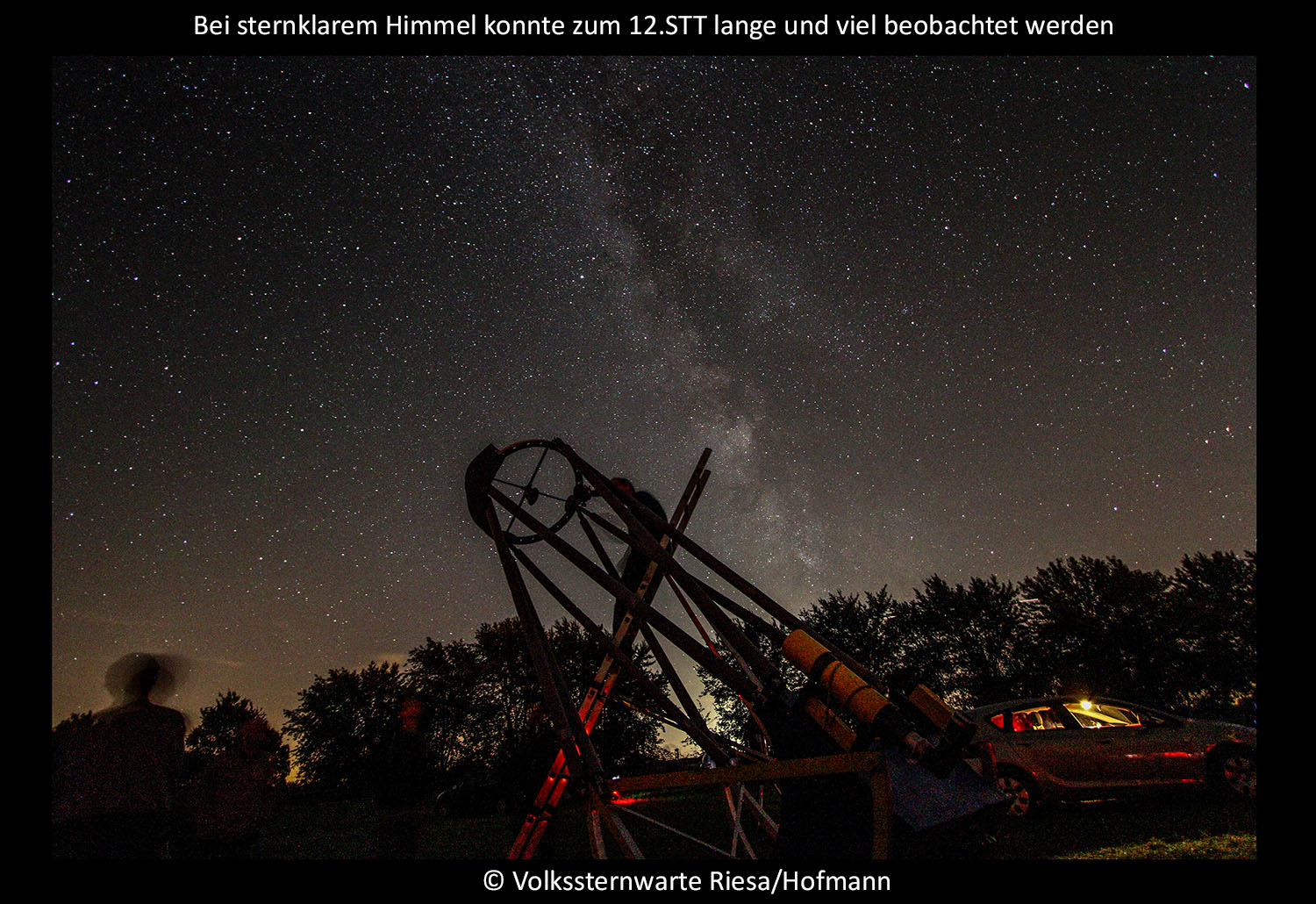
Also this year our Saxon Summer Star Party takes place at the Lindenhof in Peritz. It was a nice event with a lot of interessting discussions and presentations. Some impressions you can find at our picture gallery.
Shelf Cloud

A very impressive shelf cloud could be observed over Riesa at the 10th july 2017. This shelf cloud is a horizontal pointing arcus cloud. Such cloud formations are visible through thunder storms and high wind speeds.
Ice crystal clouds

On June 21, 2017, the 80 km high ice crystal clouds could be observed with a clear view to the north.
Great Deep Sky Object M42
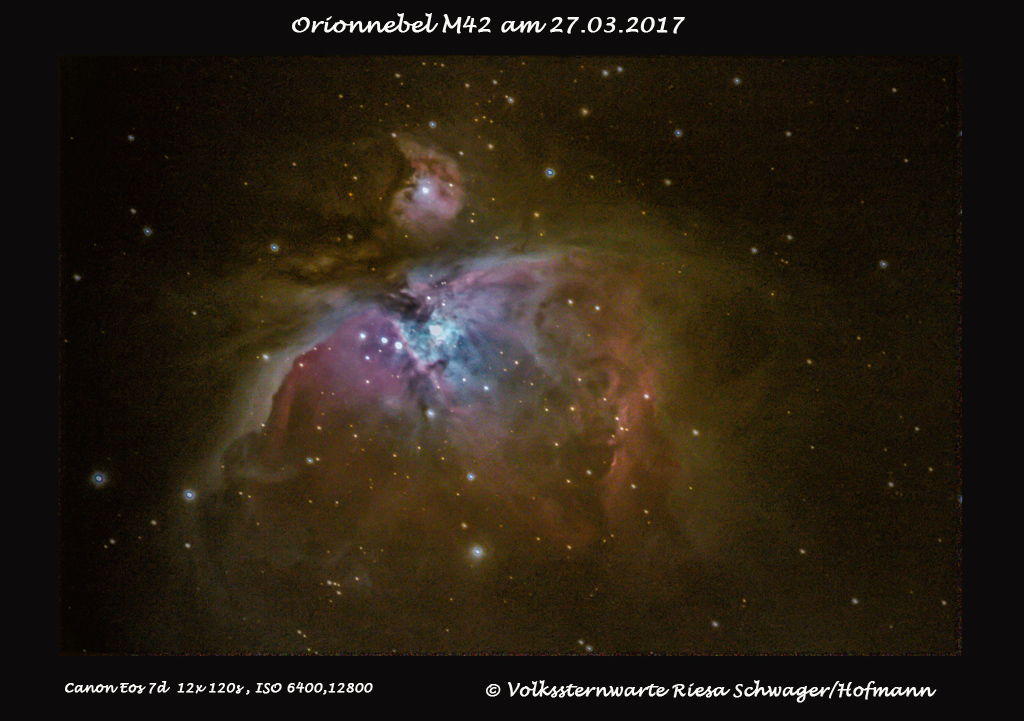
M42 is always spectacular Deep Sky object. The Orion Nebula to adopt now from the winter night sky.
Moon at telescope
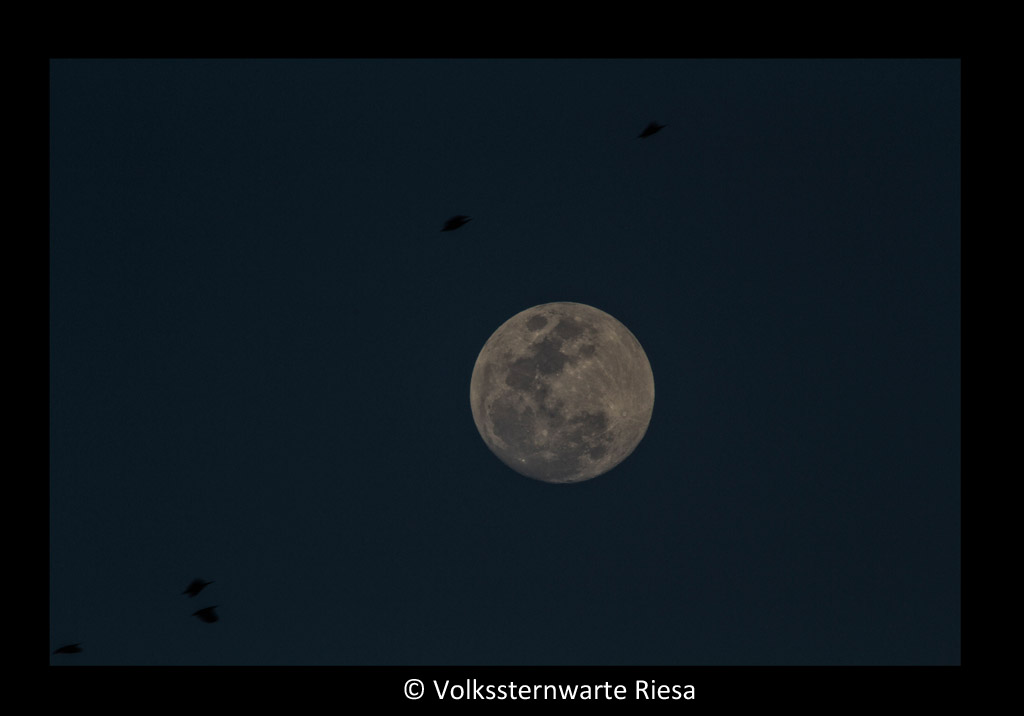
The moon always an interesting object. Photographed with a Canon EOS 7d
Observation at the observatory in Riesa
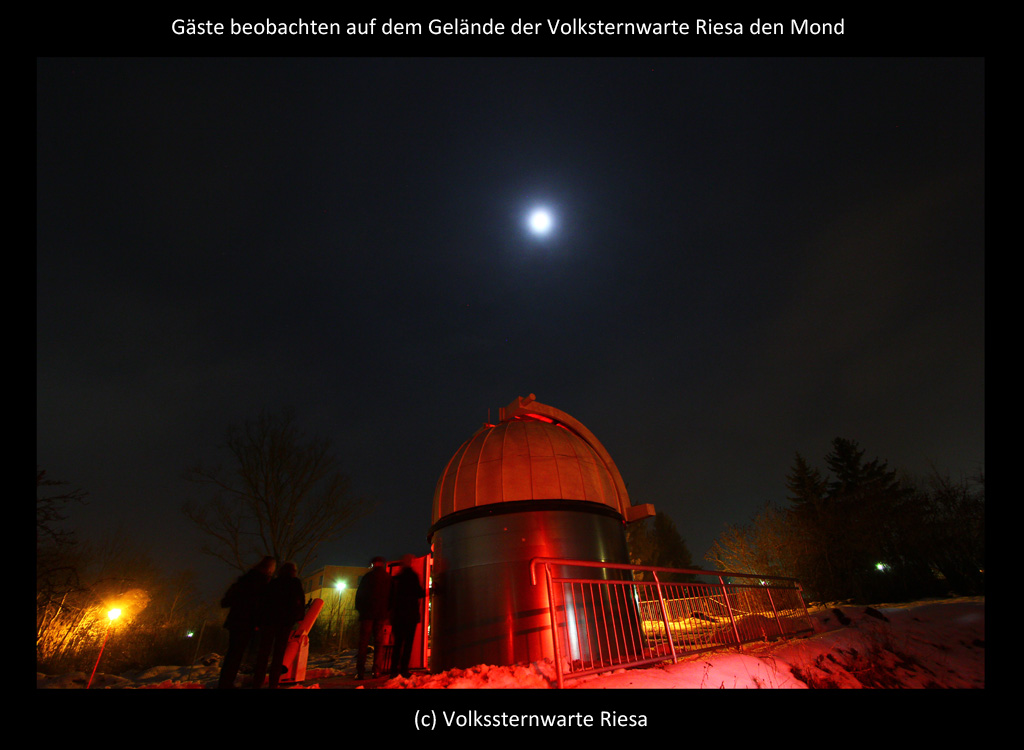
Many guests visited us this weekend. There were learn a lot about meteorites and about the moon. The moon looks particularly beautiful in the telescope.
Andromeda galaxy
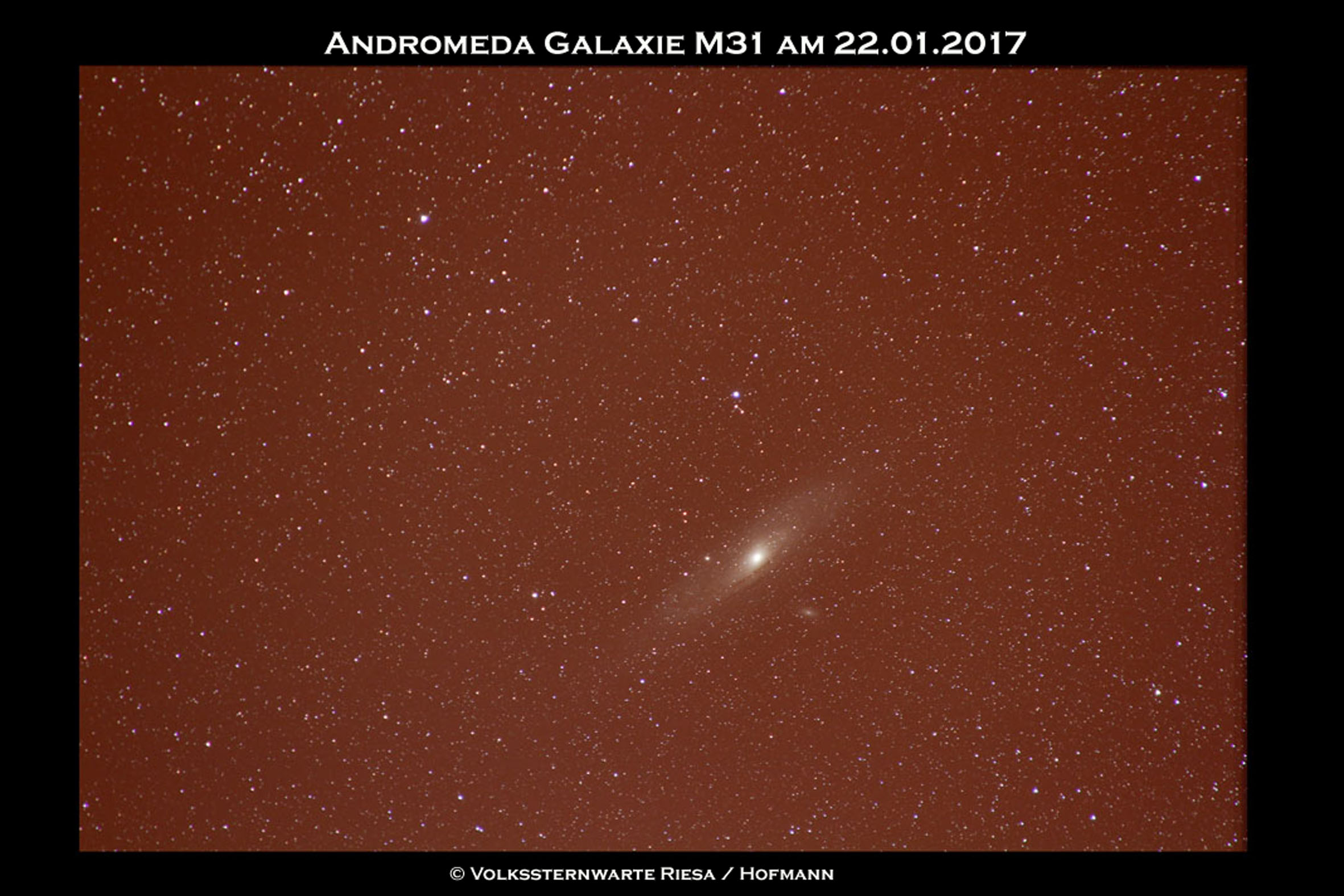
The Andromeda galaxy is a great deep-sky object and about 2 million Lj away from us. This picture consists of several individual pictures. On 22 January 2017 photographed at cold -11 ° C.
Accessible Observatory

The area around the Sternwarte is now ready. Now visitors from the street can access the gate, 100% barrier-free access to the site, to the adjoining building and to the ZEISS observatory.
Fullmoon at november
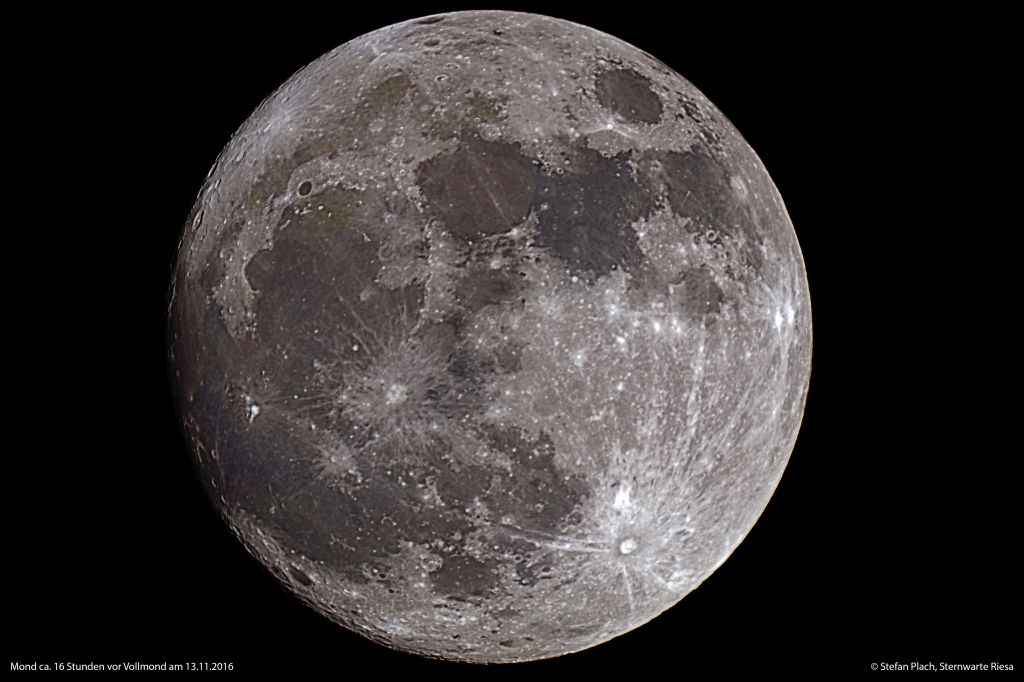
At november the 14th the super fullmoon could be observed at the night sky. One day before the moon was also shining bright at the sky. This picture is stackt with 230 single frames.
Establishment the VDS Group
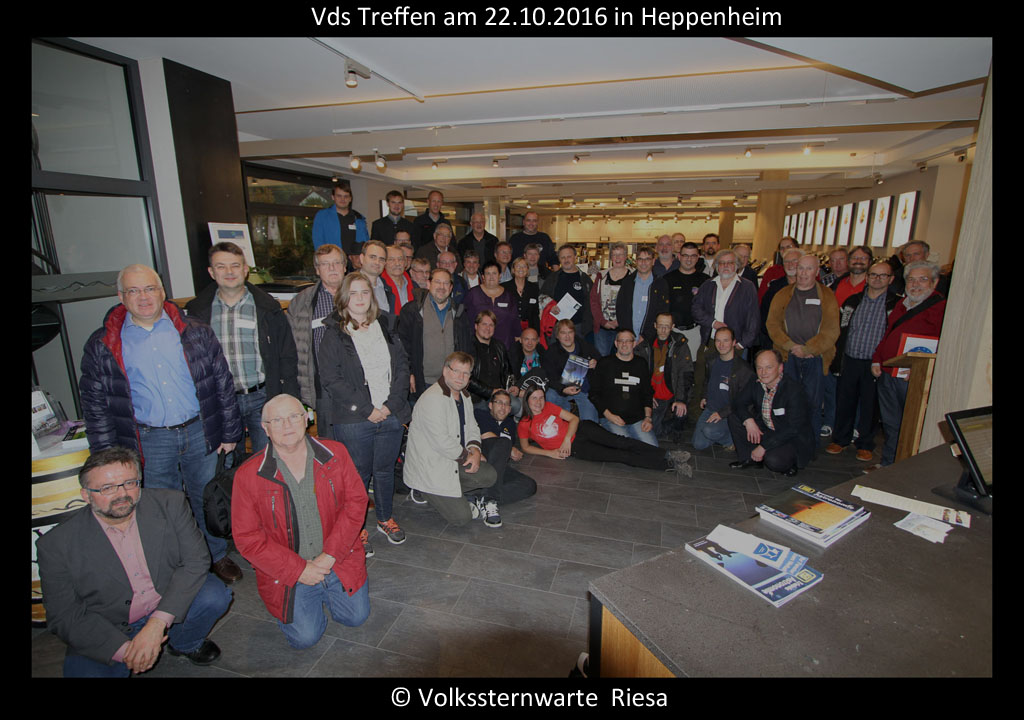
Many Observatory from all over Germany came to the invitation of the Vds and met in Heppenheim on October 22nd. .
Meet with Astronaut Hans Schlegel at the ESTEC
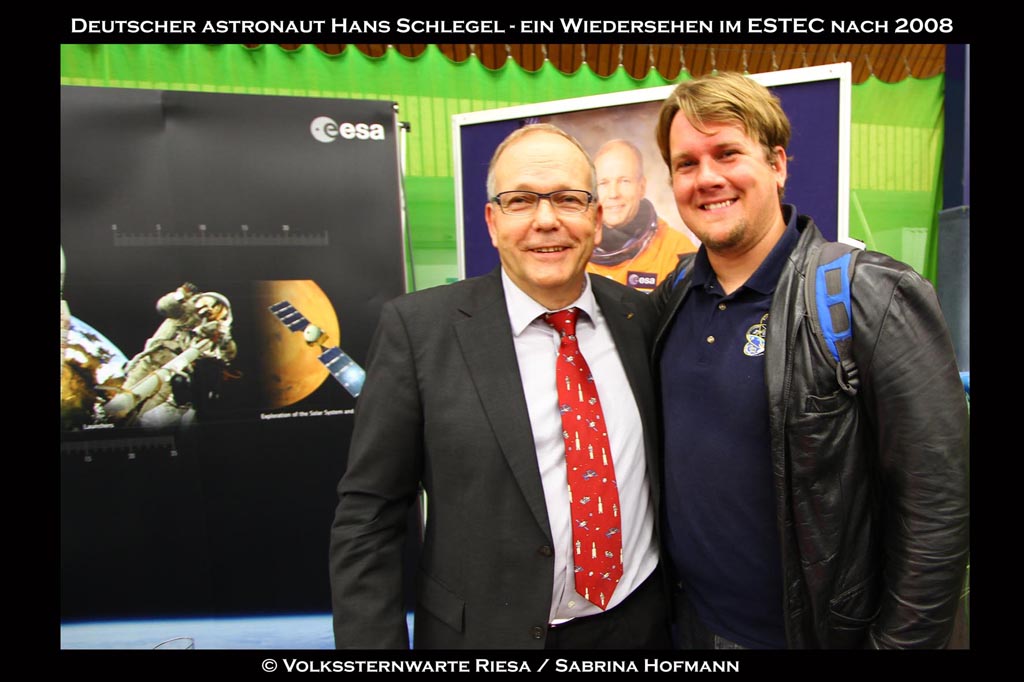
On 2 October, ESA Open day took place in Noordwijk, the Netherlands. You could visit the astronauts Franco Malerba, Hans Schlegel and Thomas Reiter. More pictures are available in our picture gallery.
penumbral eclipse
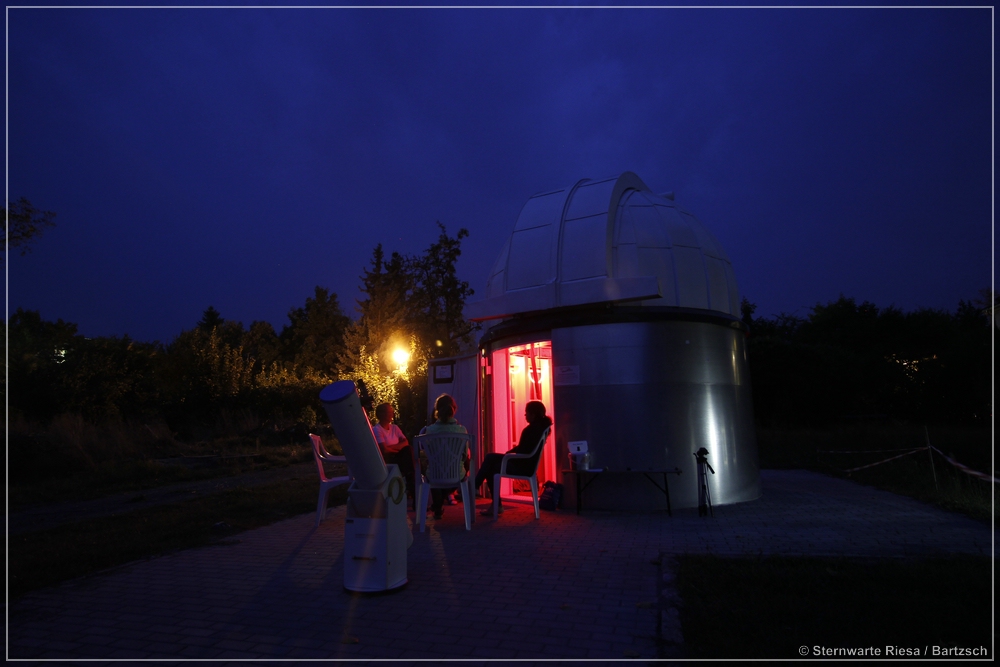
During the penumbral eclipse, we had a total cloud darkness. However, this in no way dampened the good spirits of the audience
Observation at star hour
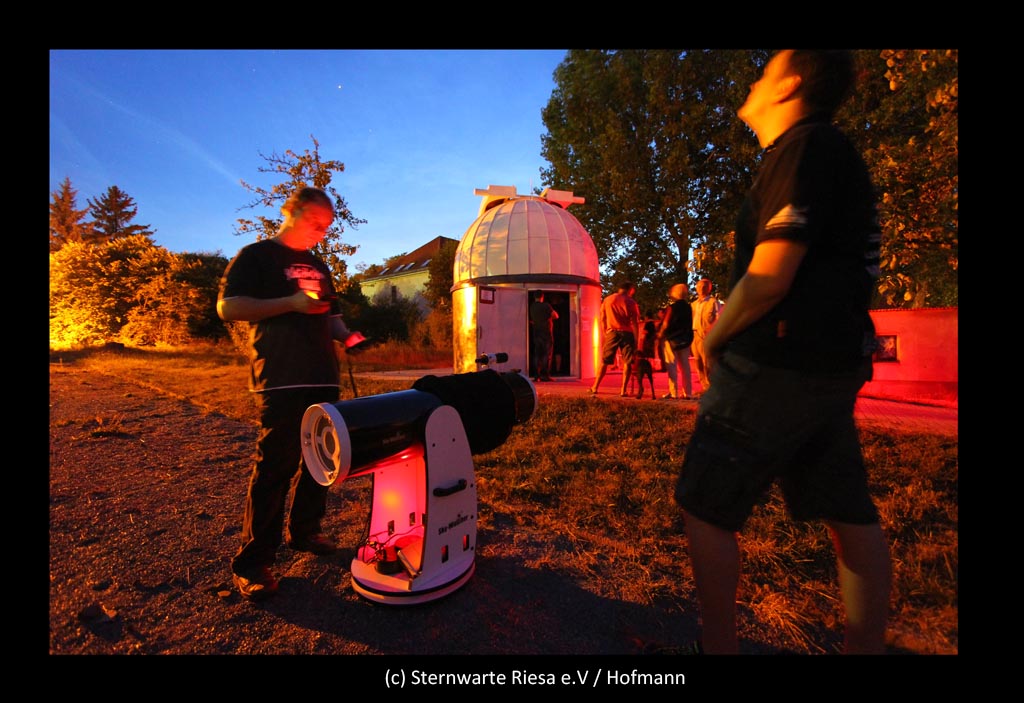
The Riesaer star hour, planet and moon in the late summer, there were many visitors to the observatory Riesa.
Annular eclipse
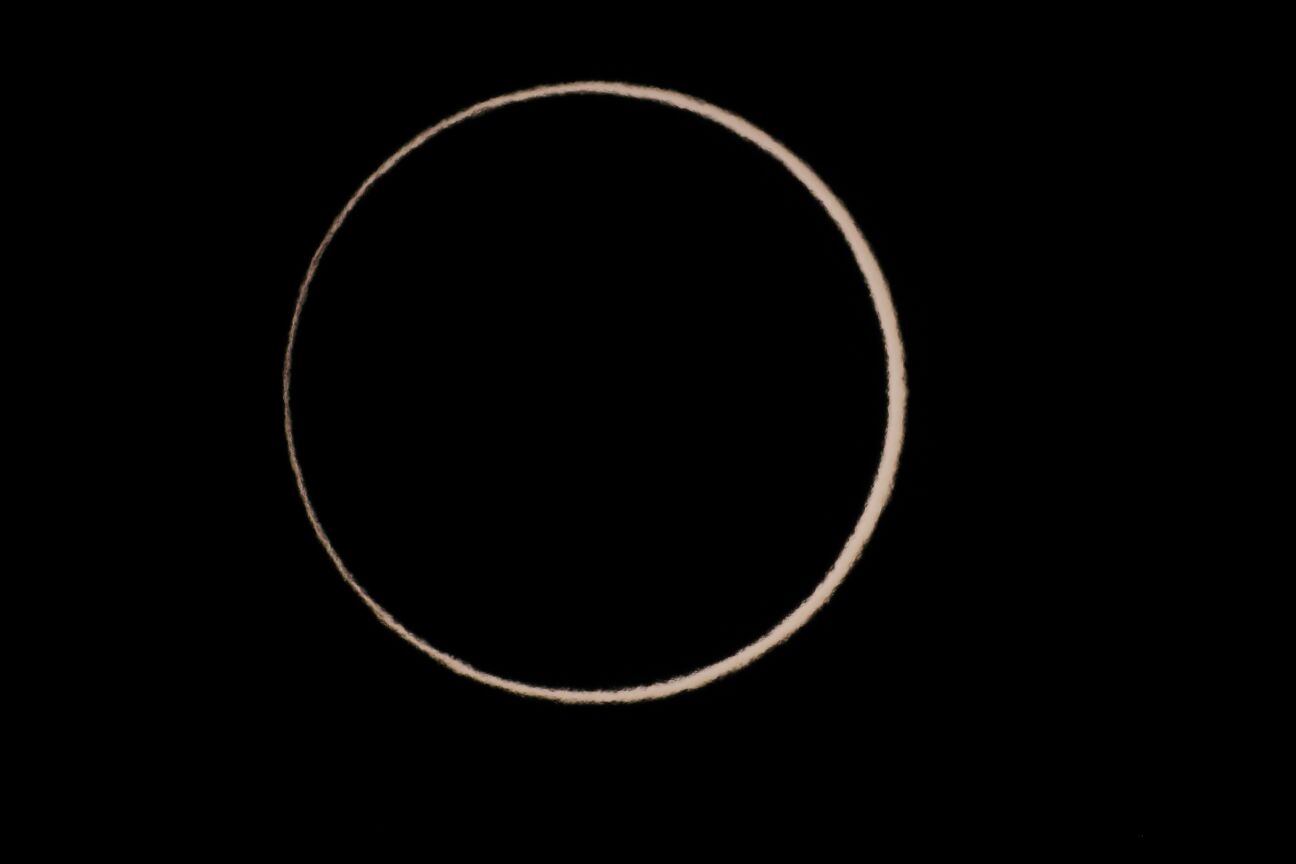
This beautiful annular eclipse could be observed on 01.09.2016 in Reunion. This small island is located next to Madagascar in the Indian Ocean.
Milkyway at august

With such a good weather at night may not be missing the observation.
11th saxon star party
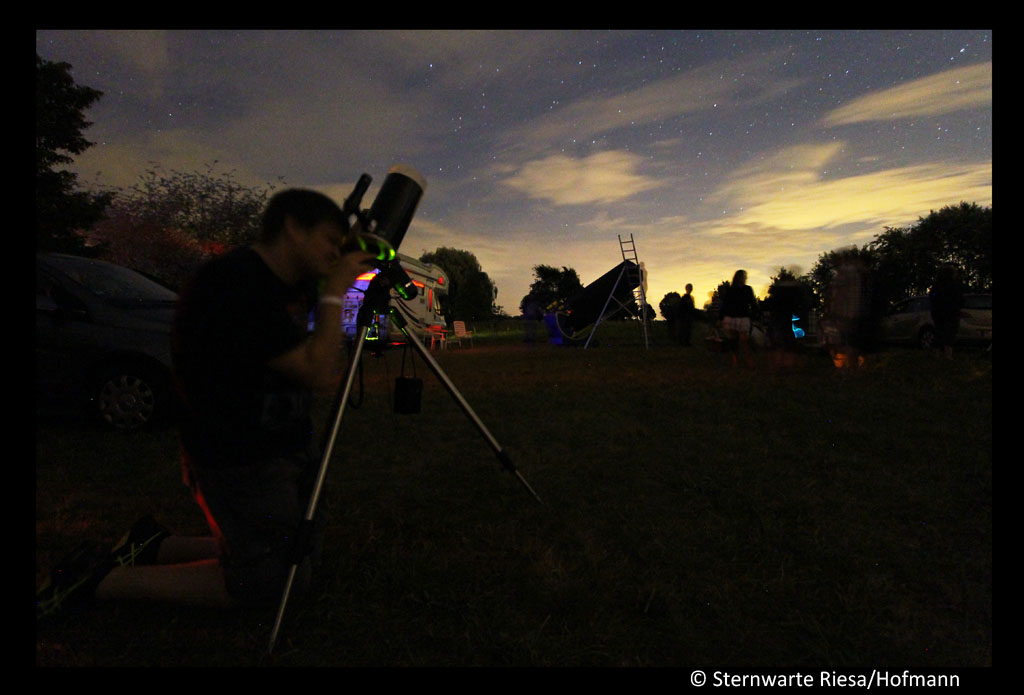
This Link allows you to the find the first great impressions from 11. STT
Observation with children
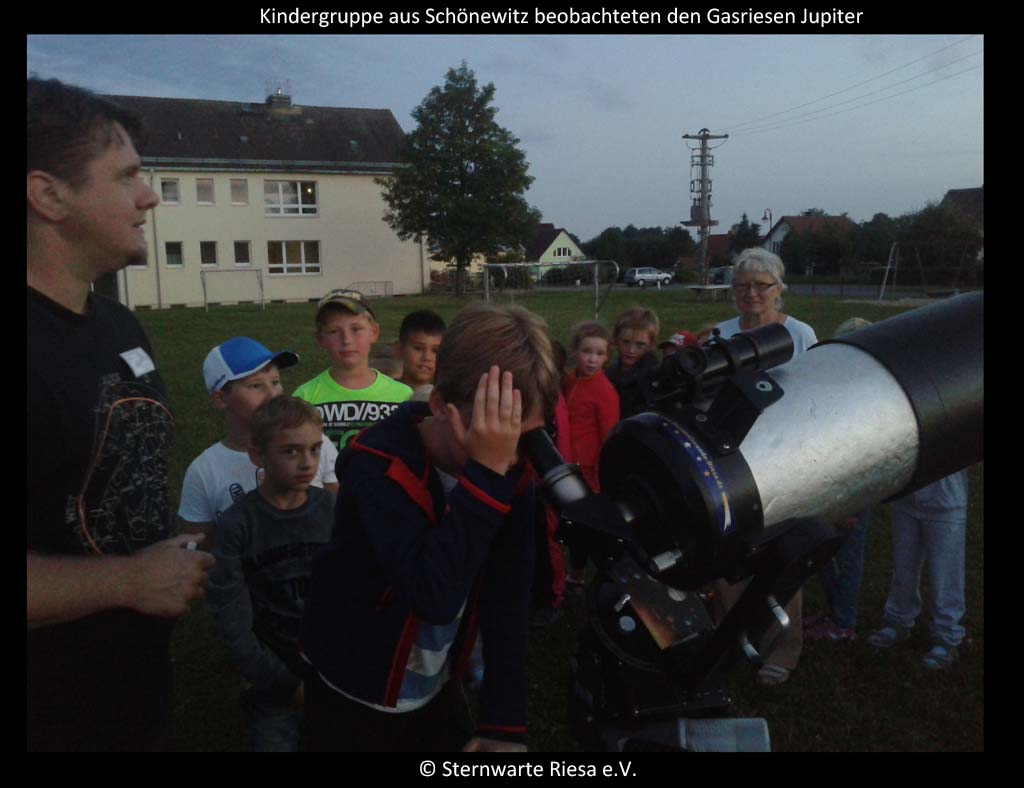
In the case of very good weather, a holiday children’s group was able to observe some of the constellations, the red planet Mars, and even the gas giant Jupiter with its cloud bands.
Prize from the Volksbank
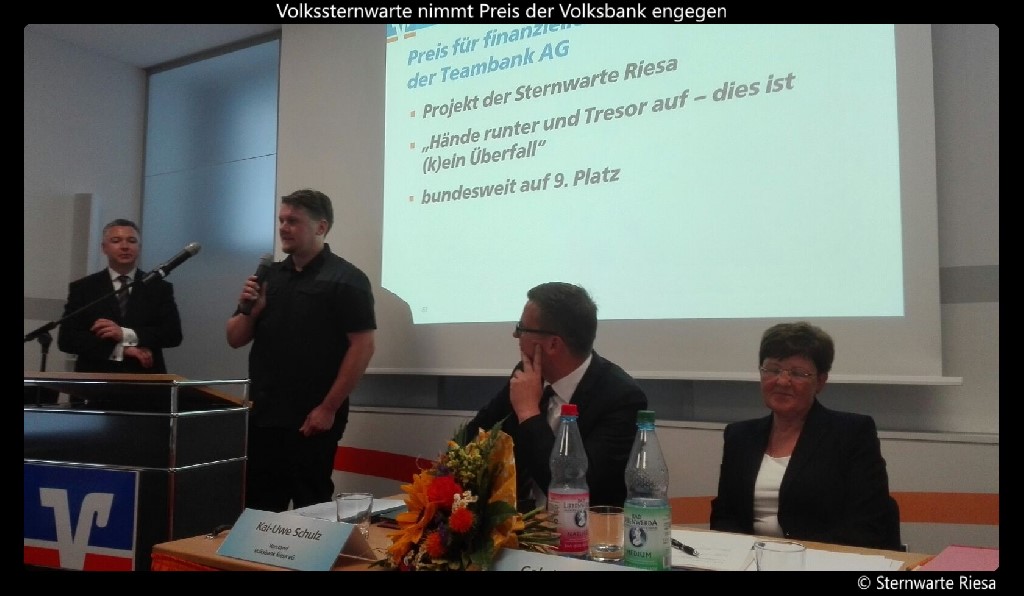
At monday the leadership of the observatory Riesa received the prize of the easy credit award of the Volksbank.
Mercury transit
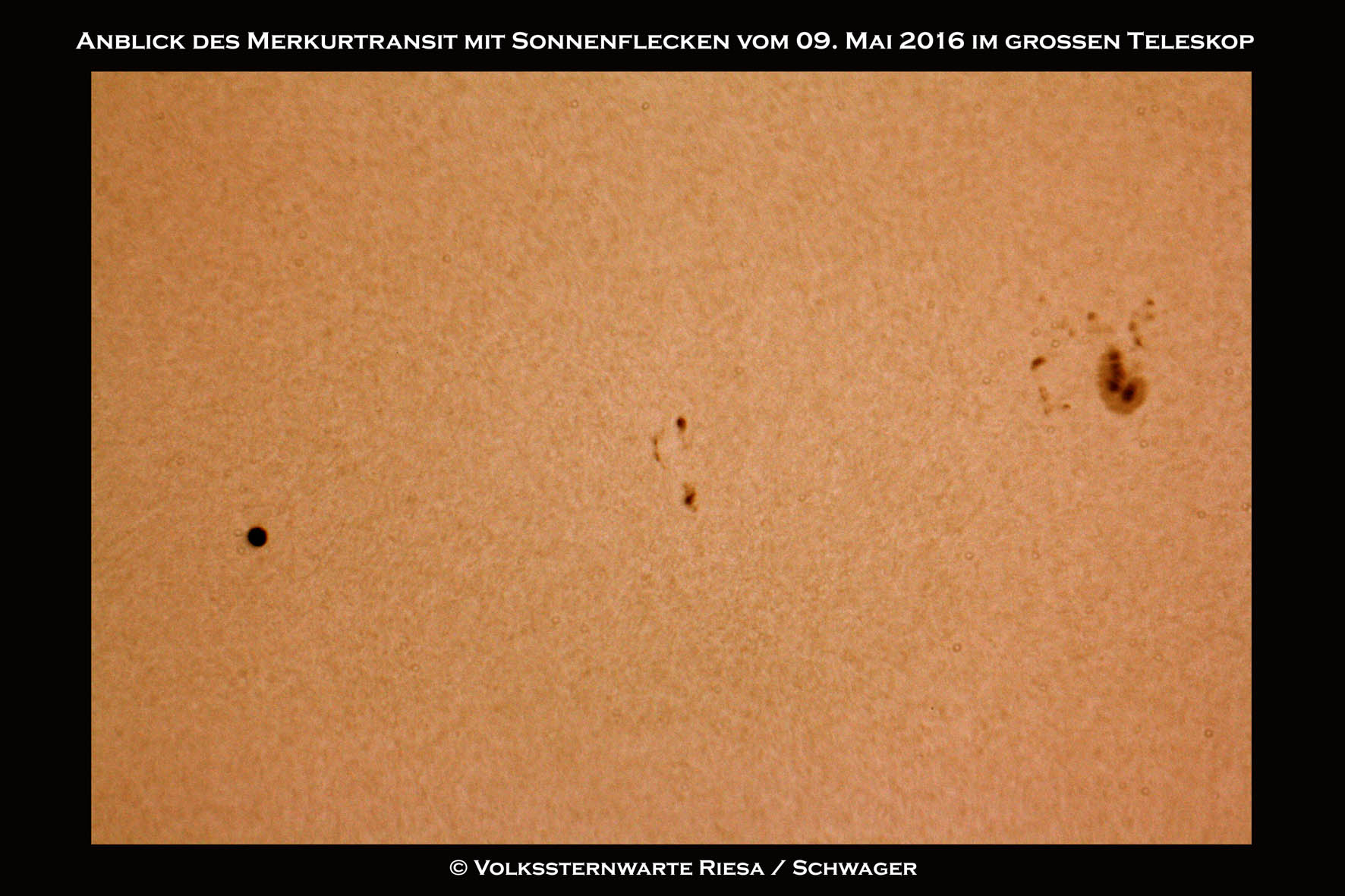
On this day was the mercury transit. The transit took 7 houers. Many visitors use this rare opportunity and looked at the sun in the observatory riesa.
Child University nominates Doctors and Professor
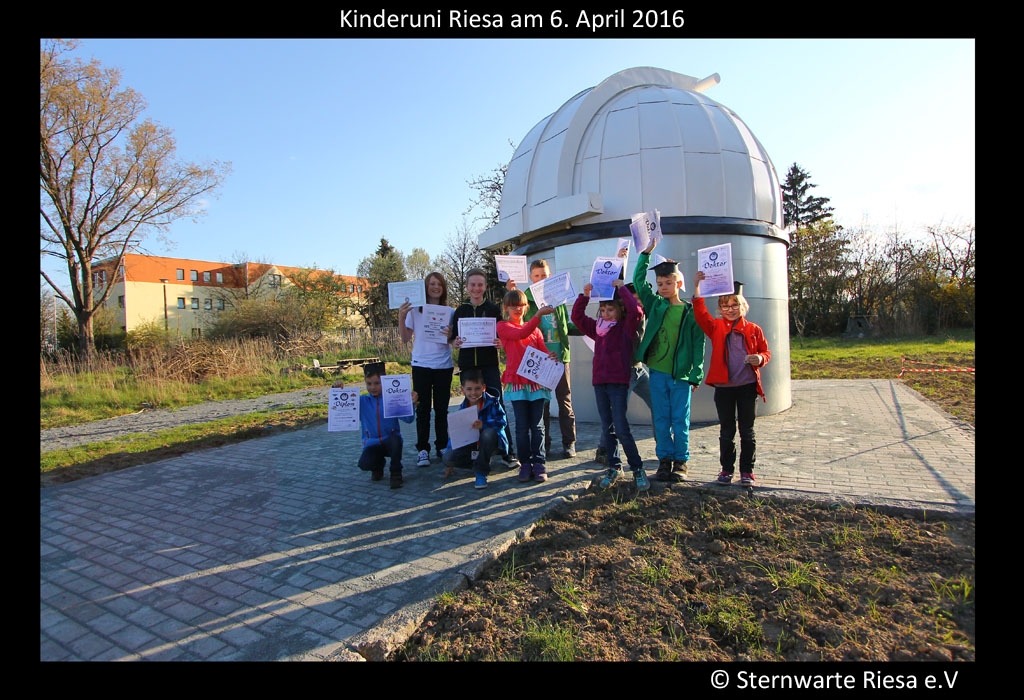
The child university of Riesa rental the titel Dr., Dr.Dr. and the first Prof. Dr.Dr.!
Donation for the Observatory Riesa
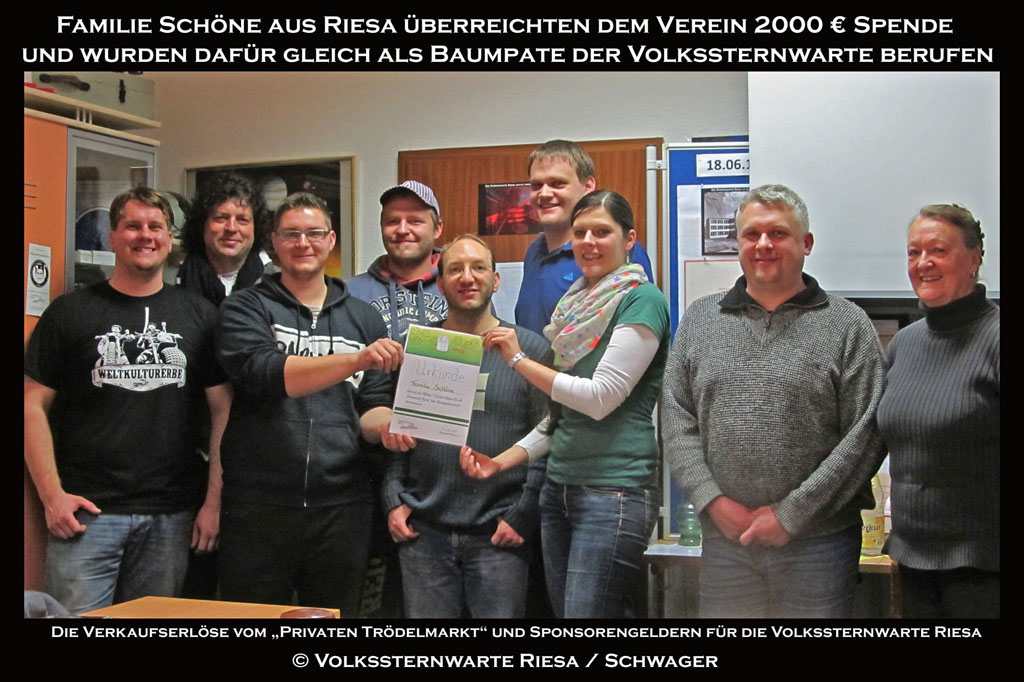
The sales proceeds and the sponsorship of private market was given the Observatory Riesa e.V. This was a great market !!
Earthshine

Despite that the moon is not fully lit, you can see the unlit side of the moon. Why is that? The light is called the ashen light or earthshine. This arises from the fact that the Earth reflects sunlight and illuminates the unlit areas of the moon.
High dynamik range image
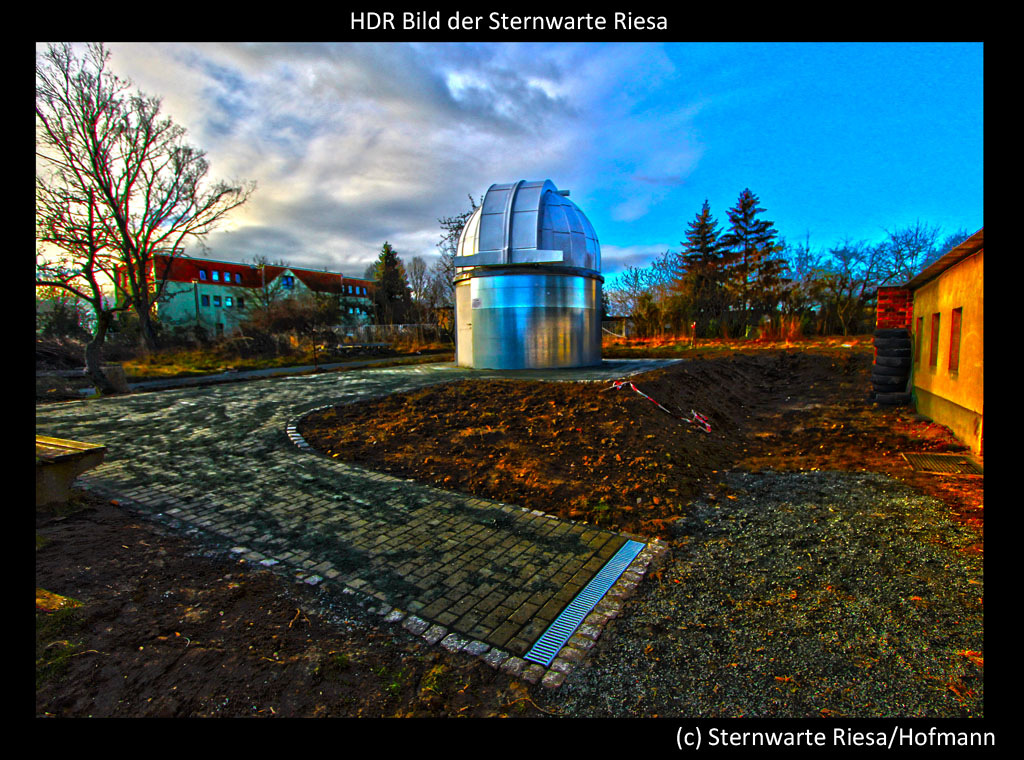
The observatory Riesa as HDR image photographed. But what does HDR? You found on this page.
Halo at Riesa
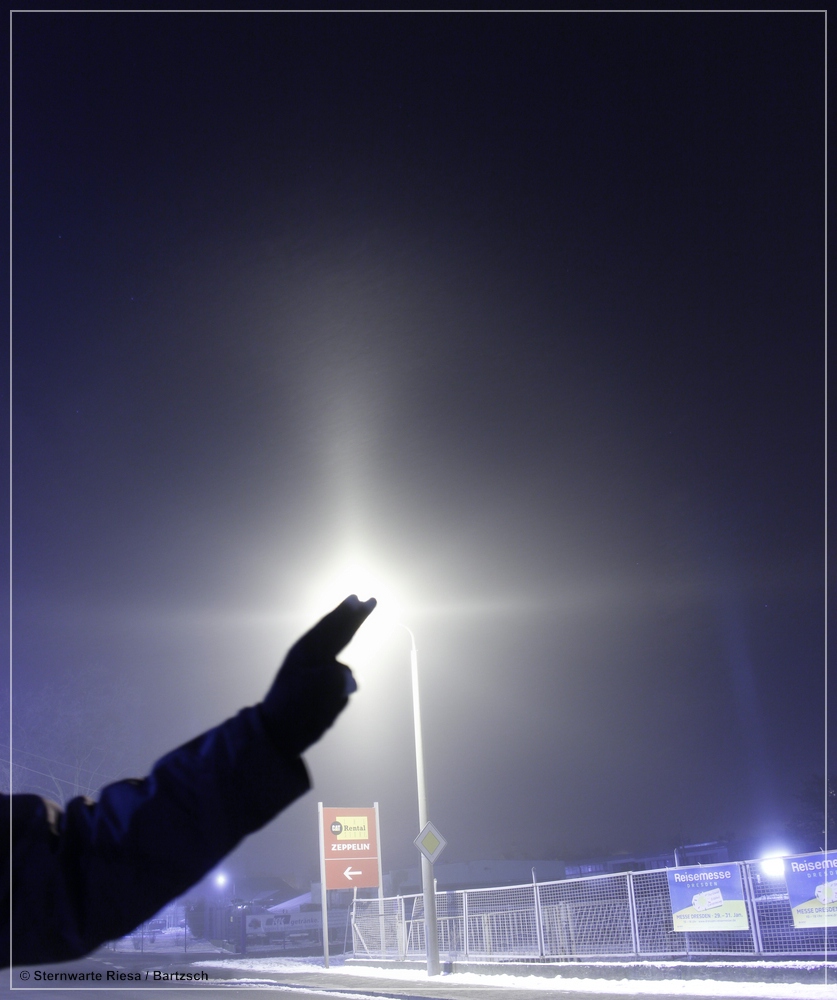
Solargrafie
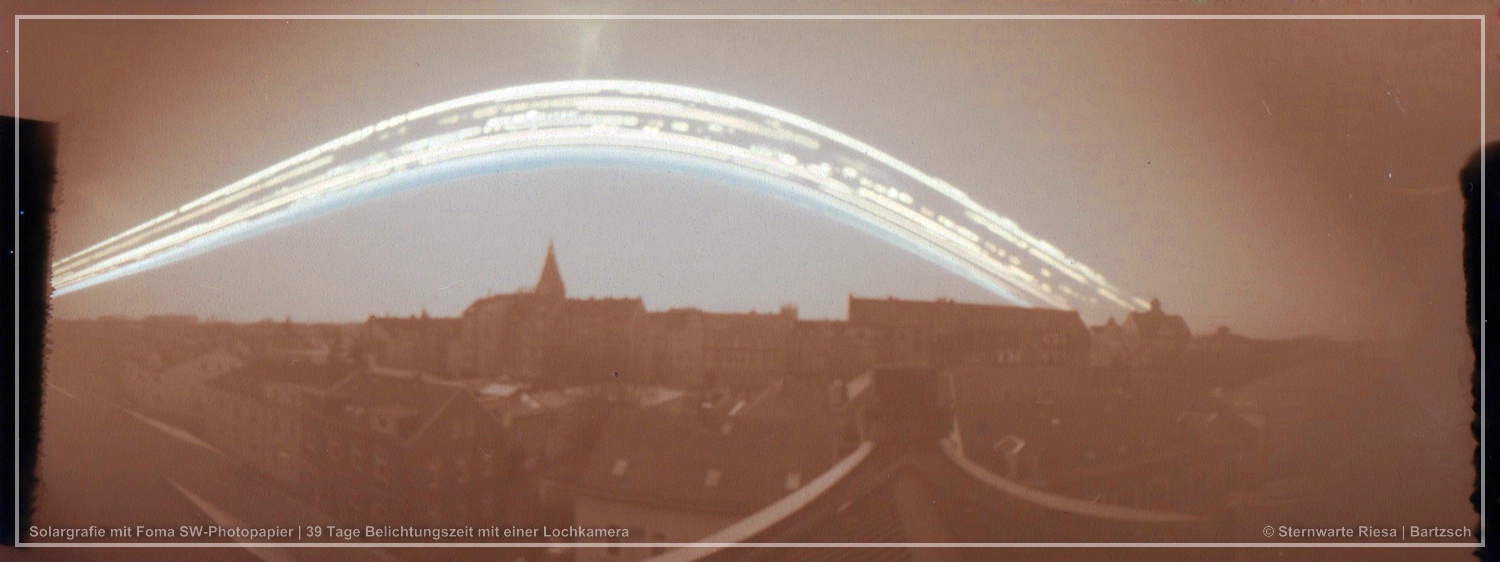
With a simple pinhole camera and a chemical black and white photograph can be the movement of the sun documented. This principle of long-term exposure is called Solargrafie. For the image in total 39 days was exposed
planet parade
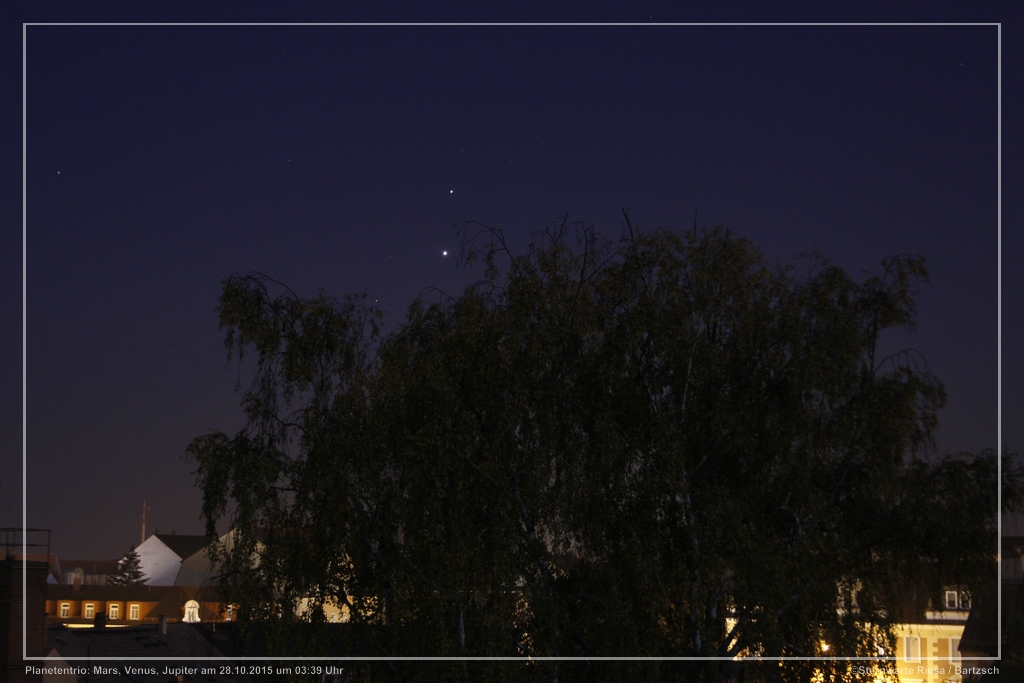
In the wee hours of the morning the planets parade can be admired by the clear skies. The arrangement of visible planets Mars, Venus and Jupiter.
Total lunar eclipse
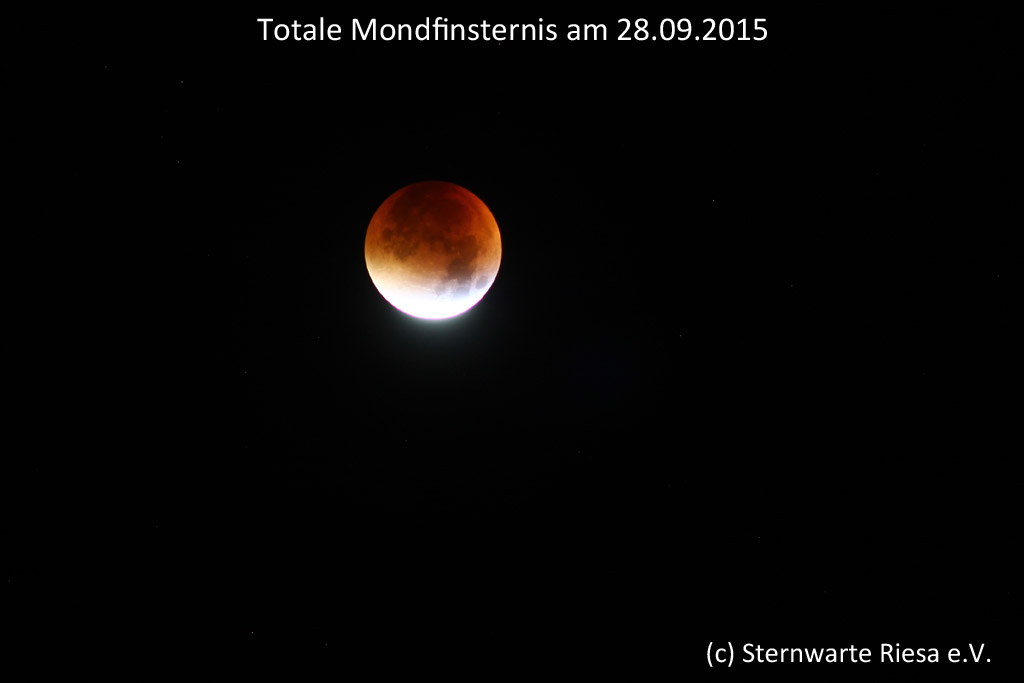
In very good weather the complete lunar eclipse took place in the morning 28. 09. 2015. A very nice spectacle of nature with which the moon dives in a red colour.
Child university
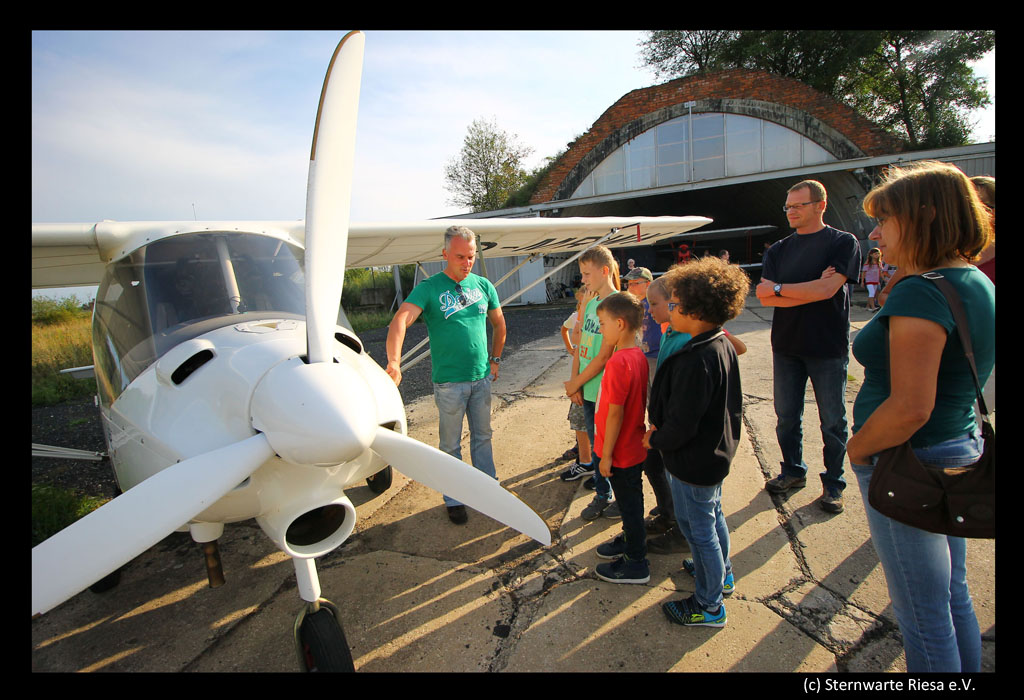
This time it went for the child university students after great grove to the airfield to Born 2 Fly. The students learnt here a lot of interesting facts over airplanes and the aviation. Even they sit down in an airplane cockpit.
Town firmly in Riesa
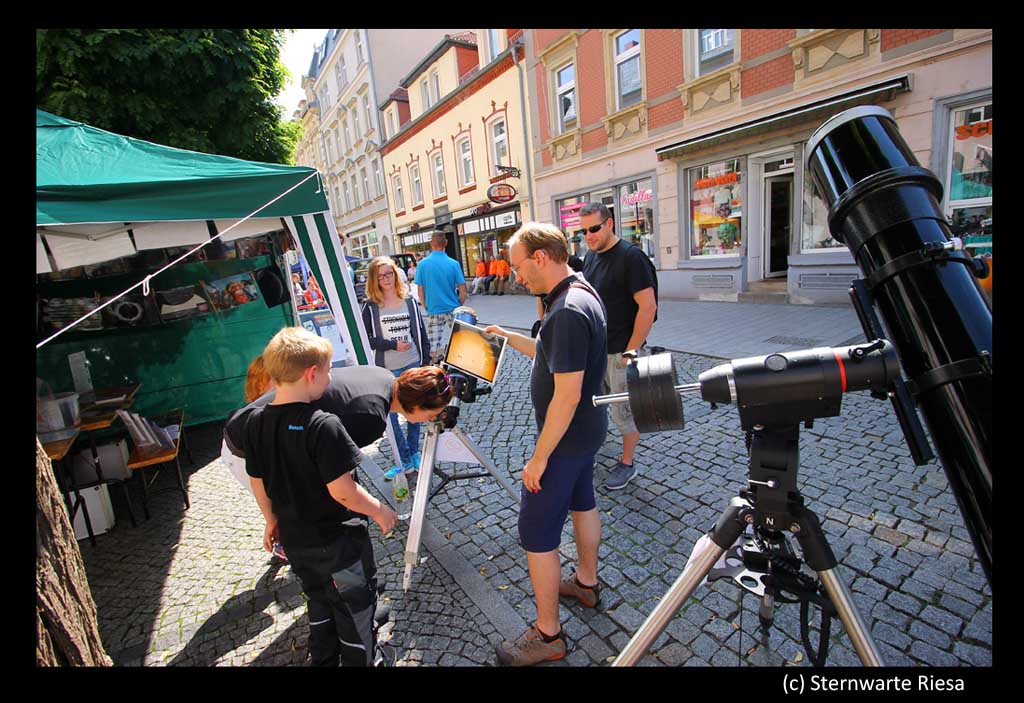
Yesterday also the star friends from Riesa were represented on the Stadfest. With telescopes the population could have observed the sun, with solar spots and protuberances.
sun spot
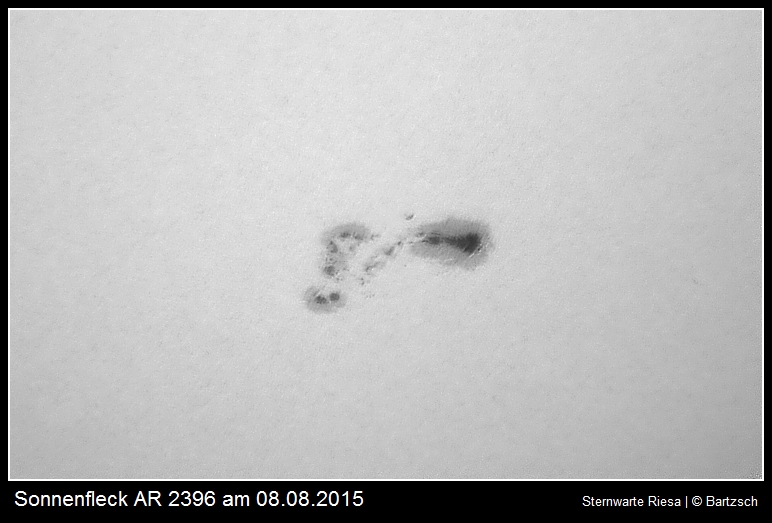
This amazing sunspot region AR 2403 is a part of the same system and is over ten Earth diameters across.
Saxon telescope meeting
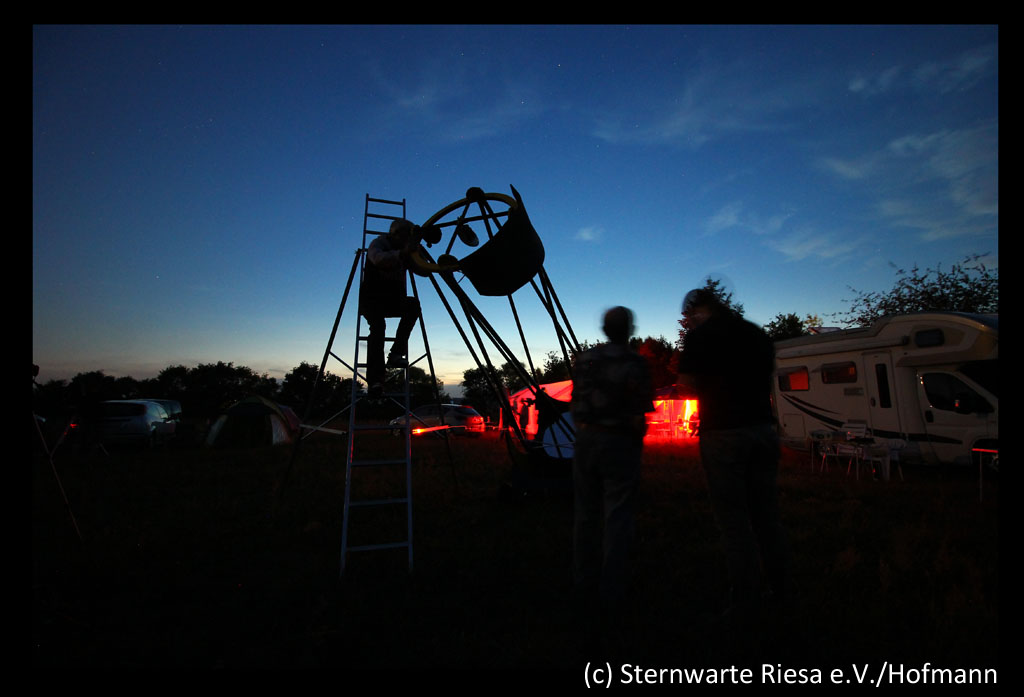
From the 24th to the 26th of July 10 finds Saxon telescope meetings in Peritz instead of. During the day there are talks and Workshops. In the evening it is observed of course, unterother with this giant telescope. Everybody is here is welcome.
Venus and Jupiter
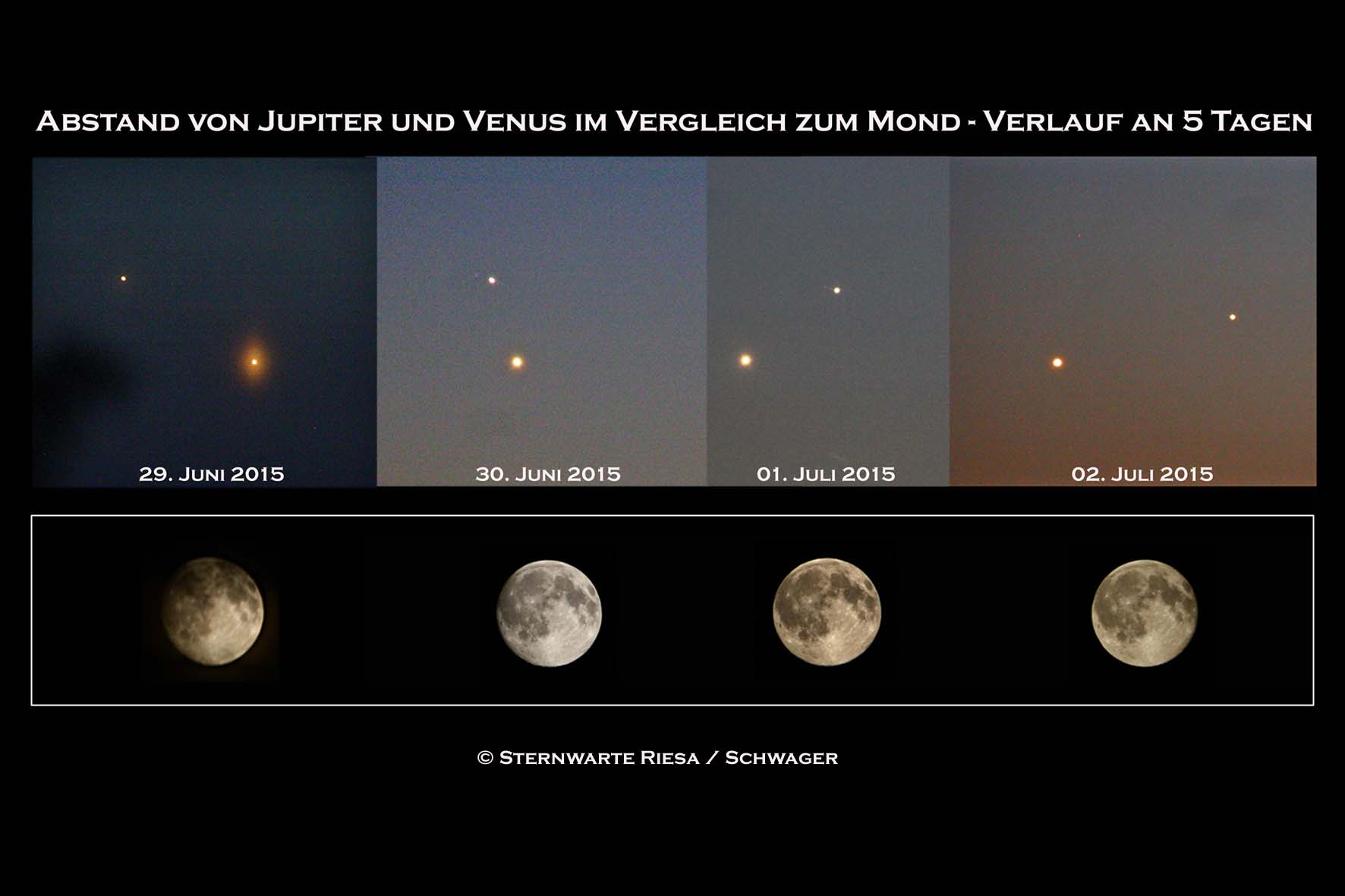
The close encounter of two planets is ever a spectecular constellation in the nightsky. These are the brightest objects after sun and moon and together they look very bright. Have You seen it? Look the next days.
Blackbird
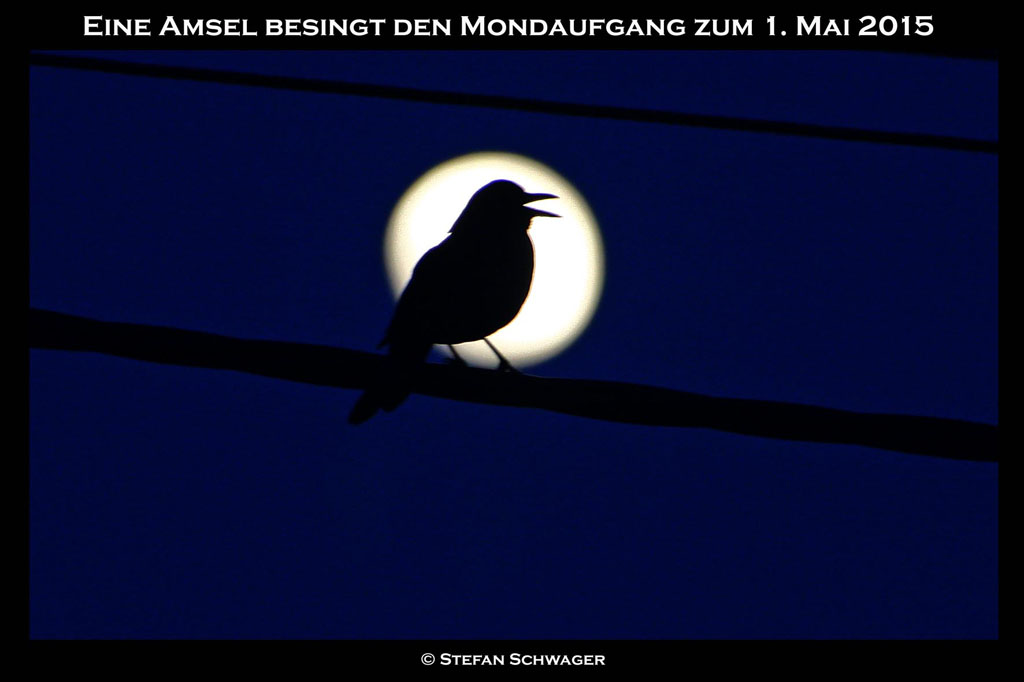
This great picture was taken on the evening of the first of May.
The photo shows a blackbird sings during the moon rise.
Sunrise in Röderau
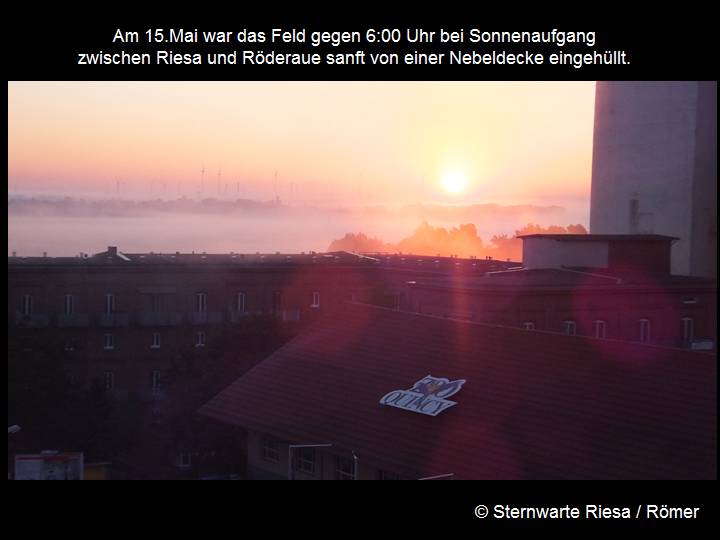
Am 15.Mai 2015 ging die Sonne über einem dichten Nebelfeld gegen 6:00 Uhr über der Roederaue auf. Der Tag selbst war sonnig und warm.
Total sun eclipse
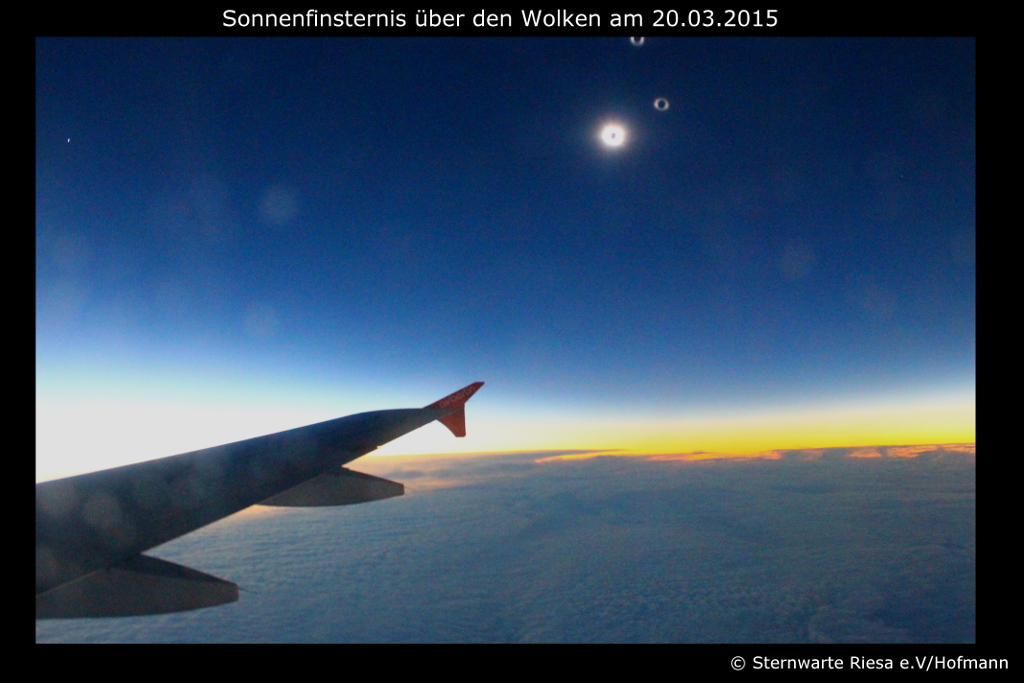
3 members from the astronomy club in Riesa could see from the plane the total solar eclipse. This sight was just AMAZING !!!!
Moon and Venus at the night sky
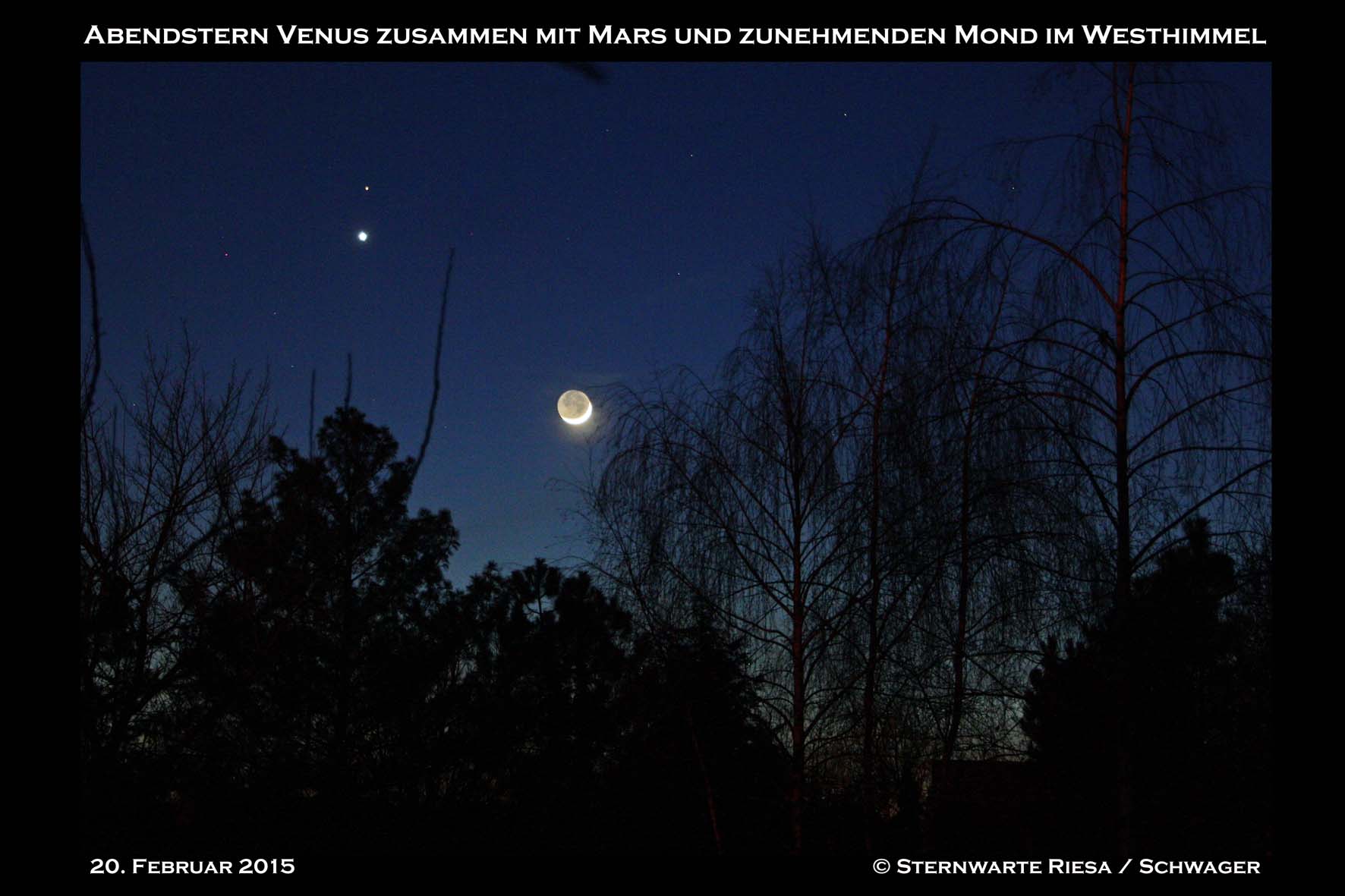
On this evening the Moon and the planet Venus were shine on the sky. It was a nice view.
Comet Lovejoy
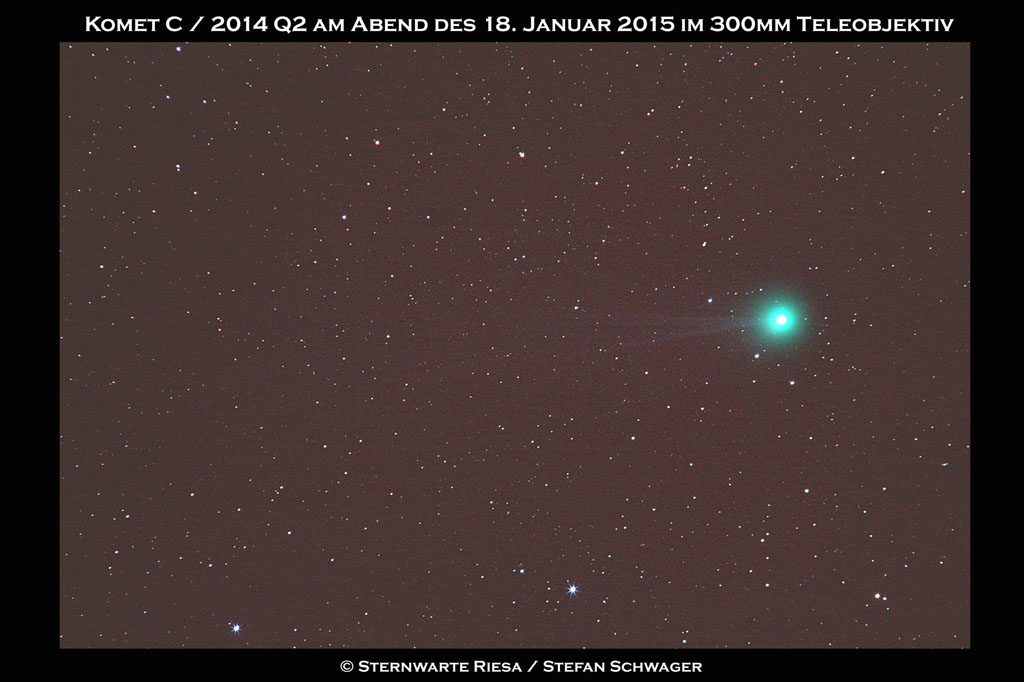
This is an actual picture of the comet “Lovejoy”. The thin tail is even seen in binoculars and the comet is visible with the nake eye. Try it to see.
Astronaut Alexander Gerst

Here you can find some pictures about the german astronaut Alexander Gerst.
Observatory Risa
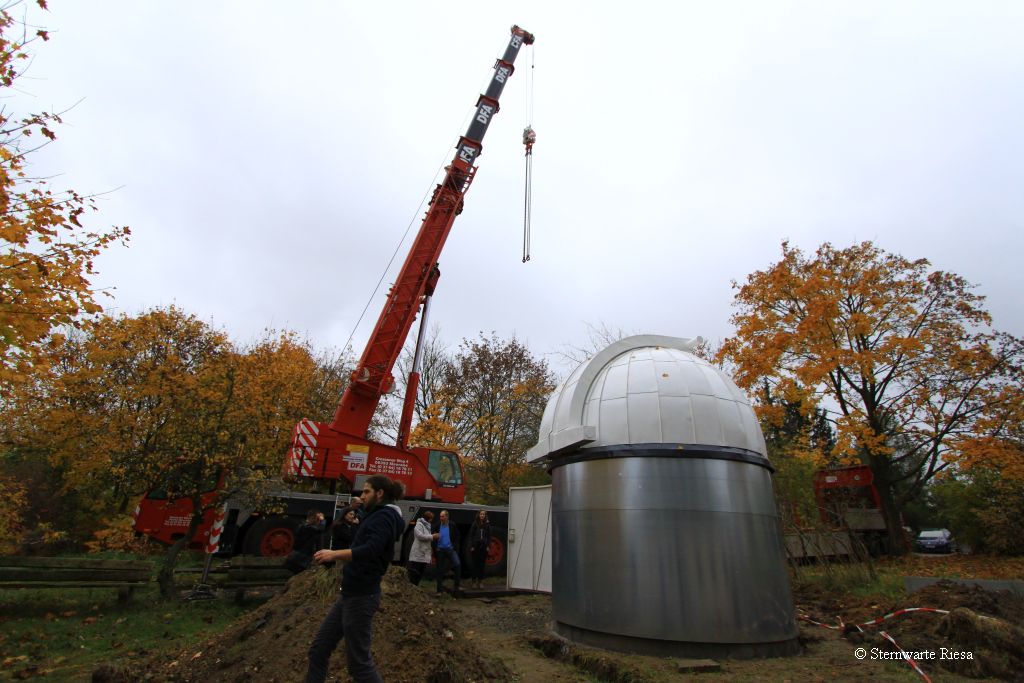
Finally! Today the observatory has covered their new place and knows in a polishing one and a new outside cover.
Harald Lesch
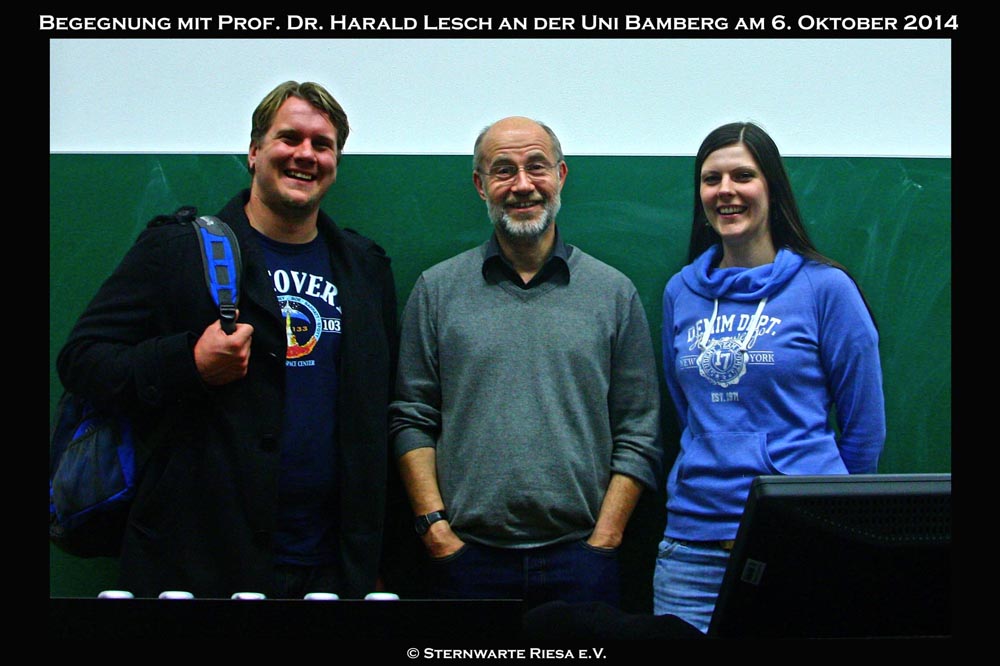
A fantastic moment for us – a lecture and meeting with Harald Lesch. He is famous for the TV shows “alpha centauri”, “Lesch`s Kosmos” and “Abenteuer Forschung”. In a very special and interesting way he explain the complex processes in space and scientific research. This picture we got at the end of the lecture.
Observatory Gönnsdorf
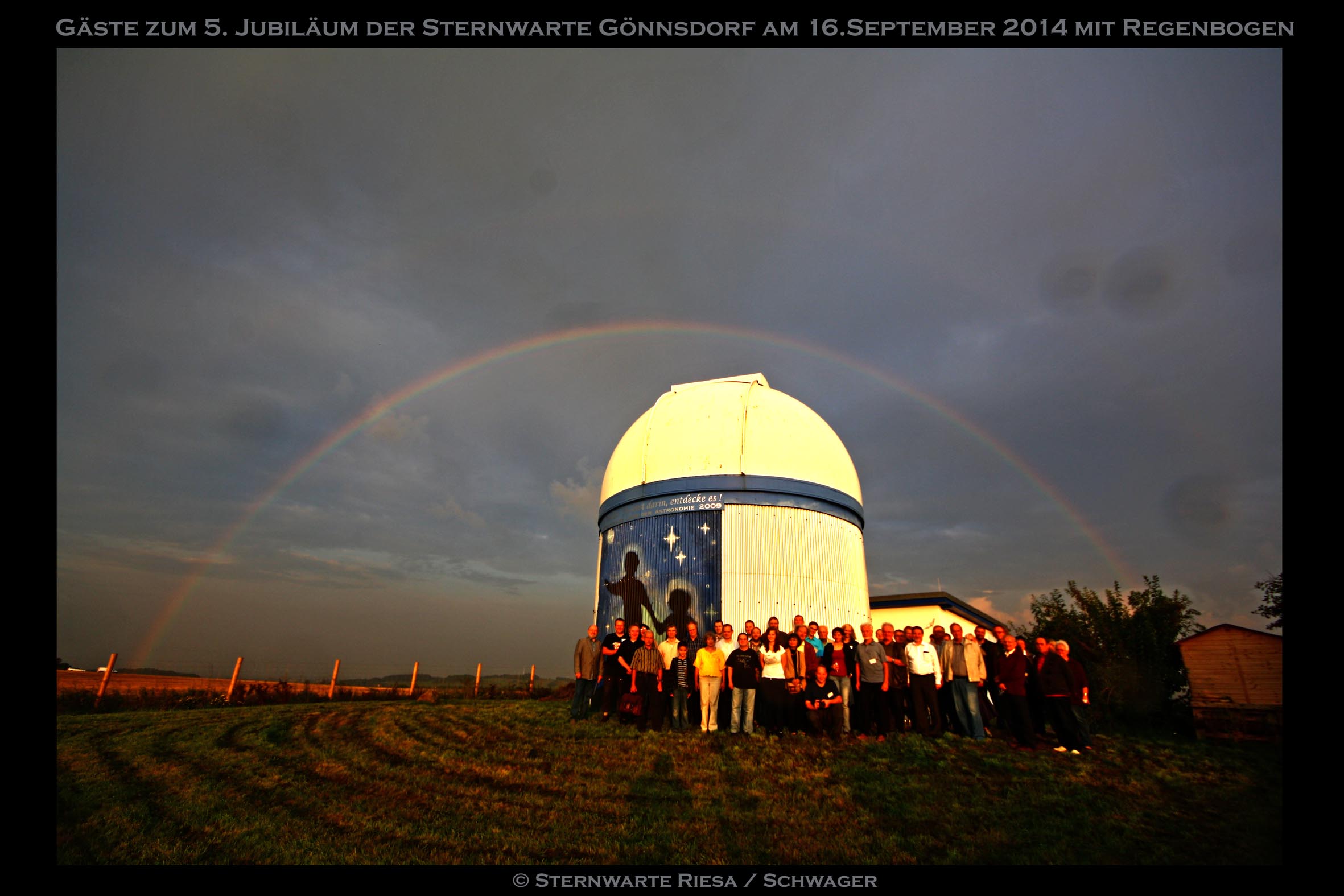
A fantastic moment for us – a lecture and meeting with Harald Lesch. He is famous for the TV shows “alpha centauri”, “Lesch`s Kosmos” and “Abenteuer Forschung”. In a very special and interesting way he explain the complex processes in space and scientific research. This picture we got at the end of the lecture.
Space Shuttle Atlantis
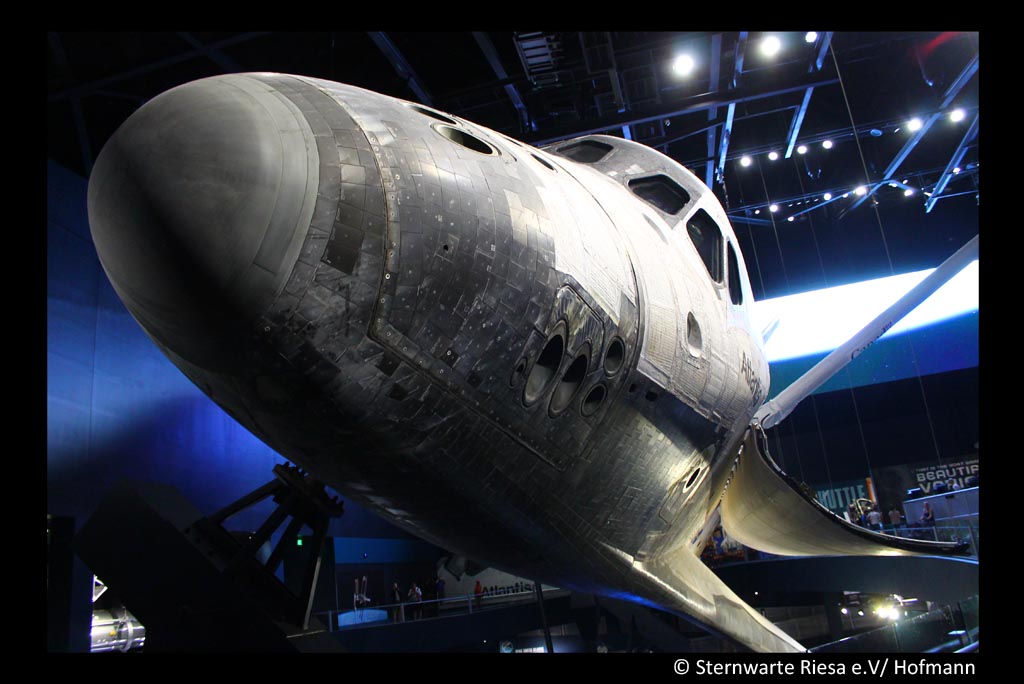
You can visit the Space Shuttle Atlantis in the Kennedy Space Center in Florida. This Shuttle isvery tall and it is the last Shuttle, they start from the Kennedy Space Center
Space Shuttle Enterprise
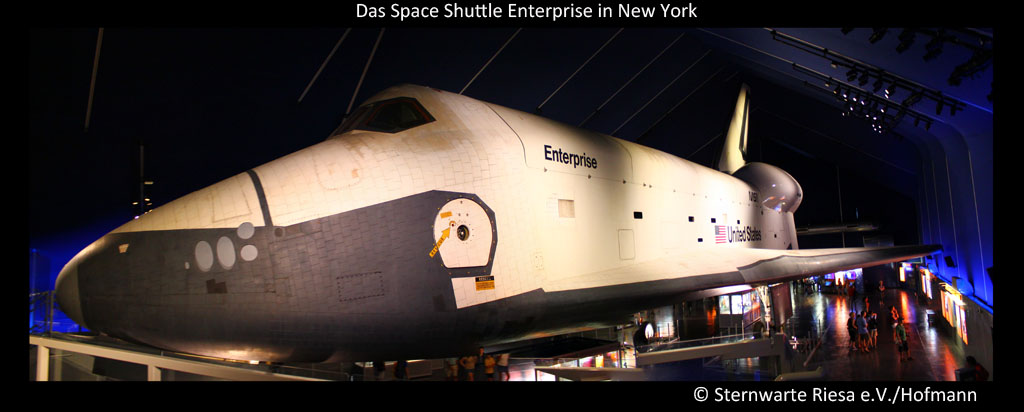
You can see the Space Shuttle Enterprise in New York at the Intrepid Sea, Air and Space Museum. This is located on Pier 86, 12 Ave and W 42 St. It is very amazing und you learn many about spacecraft
Planet Jupiter and Venus
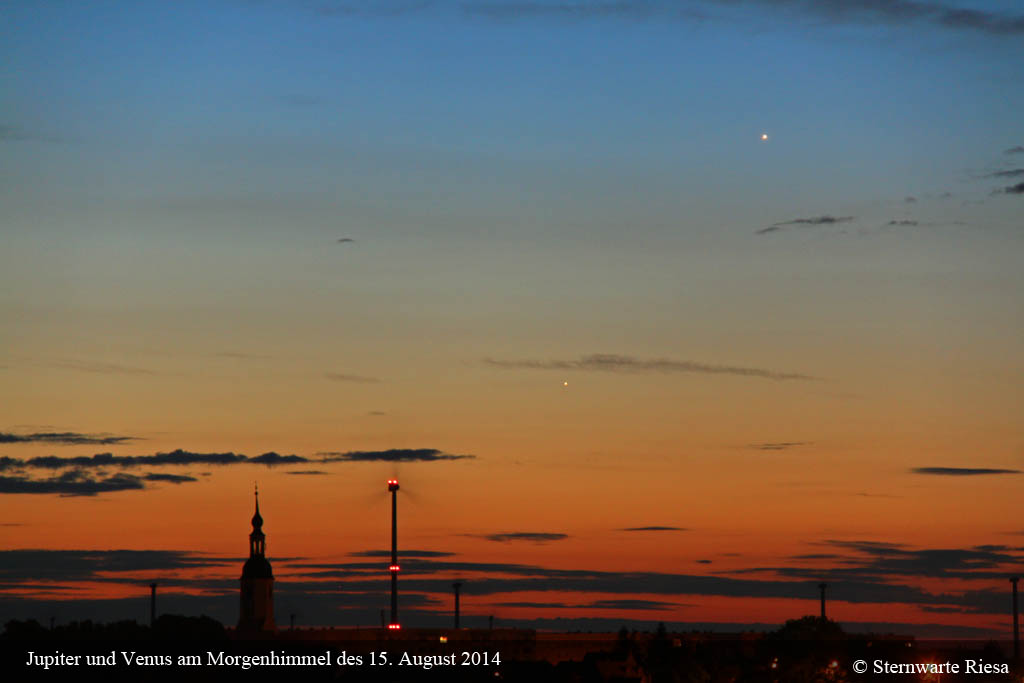
At this time the falling star nights take place on the airfield Canitz. But also at the morning sky beautiful things take place. In the morning sky you can see the planets Jupiter and Venus as bright dots. At the morning of the 18th August both will be very close together.
Sun observatoin with kids
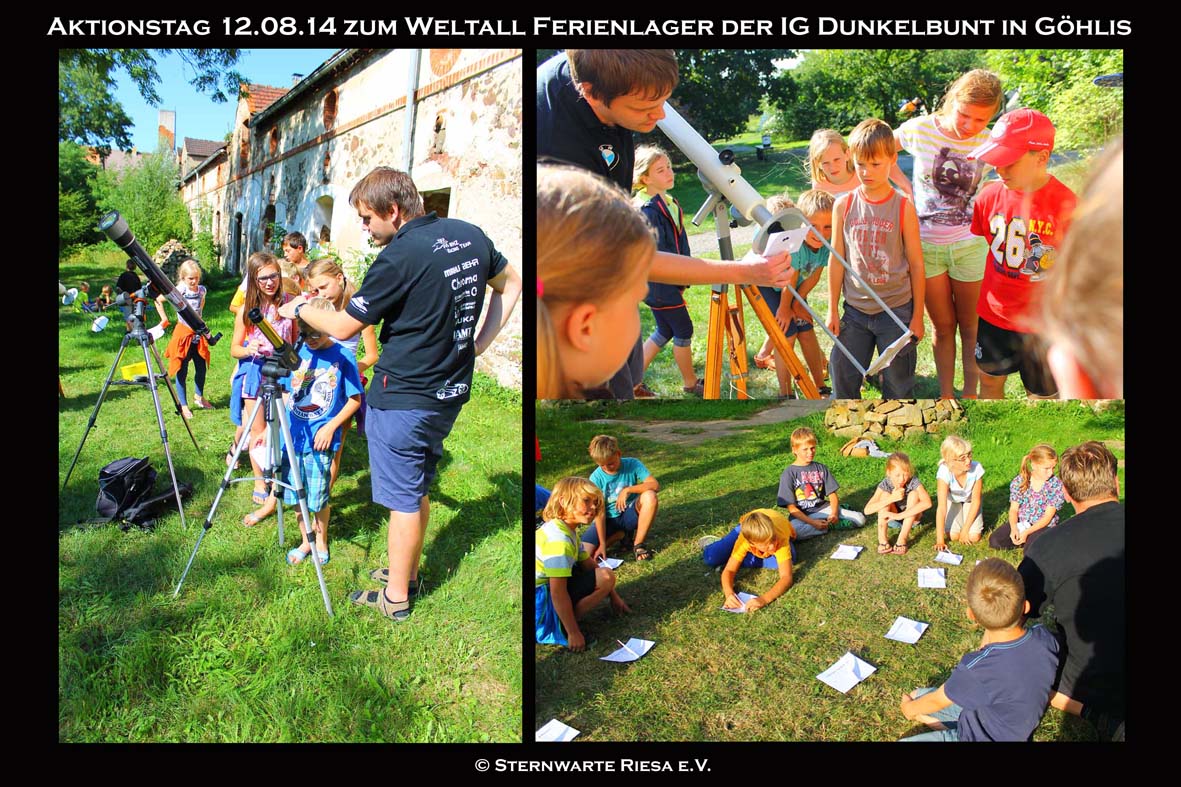
Members of the Observatory Riesa visited the kids on holiday of IG Dunkelbunt and craft ended Telescopes and sundials. The beautiful weather allowed a safe view to the spotted sun.
Fruit presentation
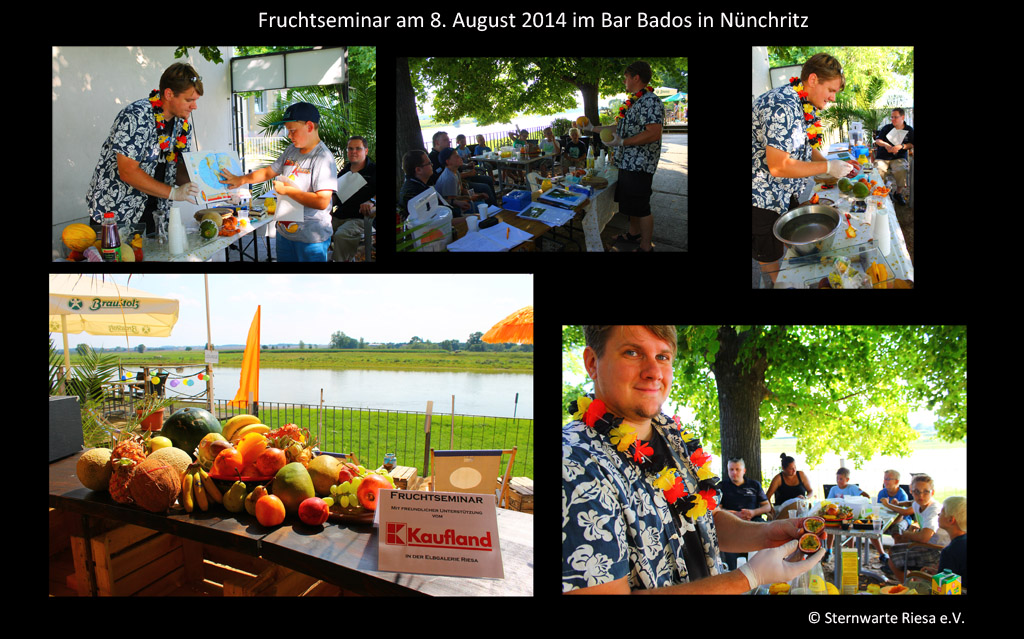
Today there was a very interesting fruit seminar at the bar Bados in Nünchritz. Besides, the participants might also try the tasty, tropical fruits and test their taste. From coconut to pomegranate everything was present. The fruits were sponsored by purchase country Riesa. Thank you for your cooperation!
Thunderstorm in Riesa
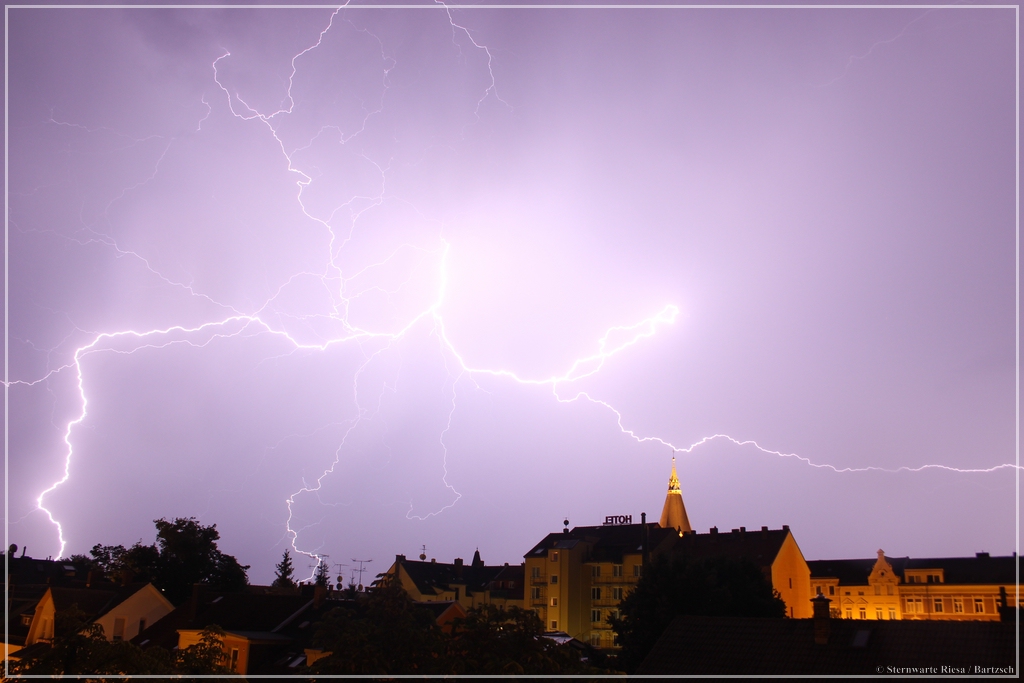
The Show must go on: Now arrives the thunderstorm with bright lightnings over the town Riesa. By the way, the lightnings can be tracked. On this page lightningmaps you can see the realtime lightnings over Germany
Great Thunderstorm
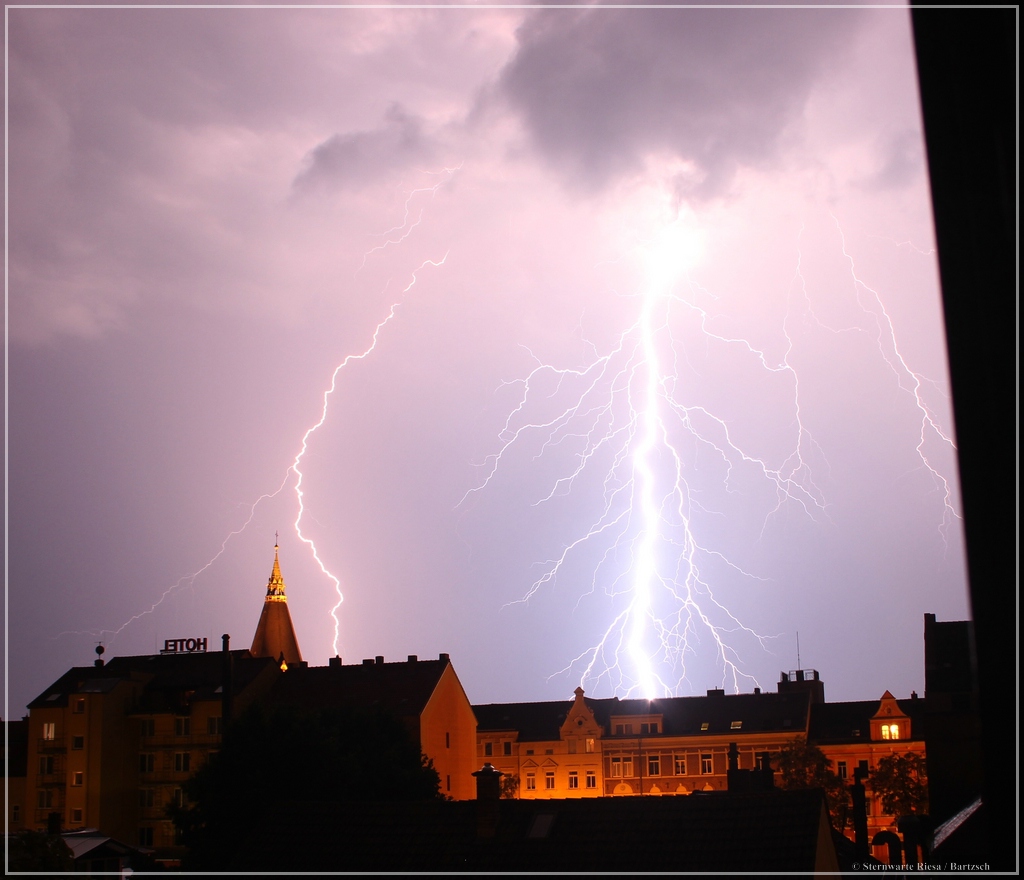
Just now comes up a heavy thunderstorm over Riesa with many lightnings. On this picture can you see some spectacular lightnings over the Trinity Church.
Sun in different wavelength
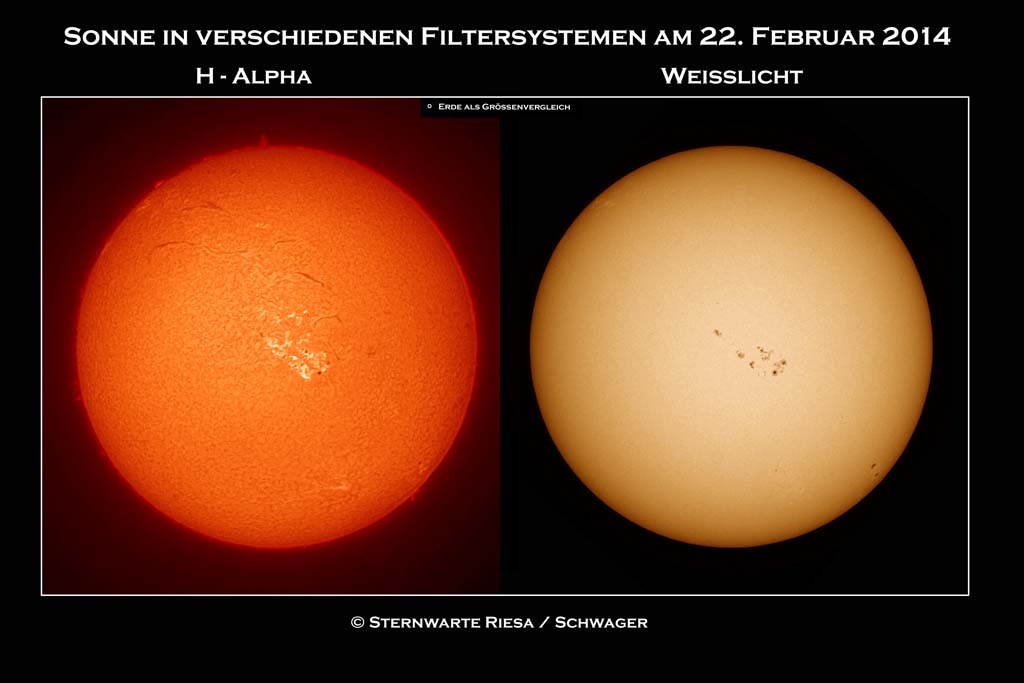
This is a composit of two pictures from our sun in differnet wavelength. One is calles the white light, with visible sunspots on the surface and the other is the hydrogen light where you can see the activities around the dark spots, like flares and eruptions. It changes from day to day – have a look!
The sun in a special filter
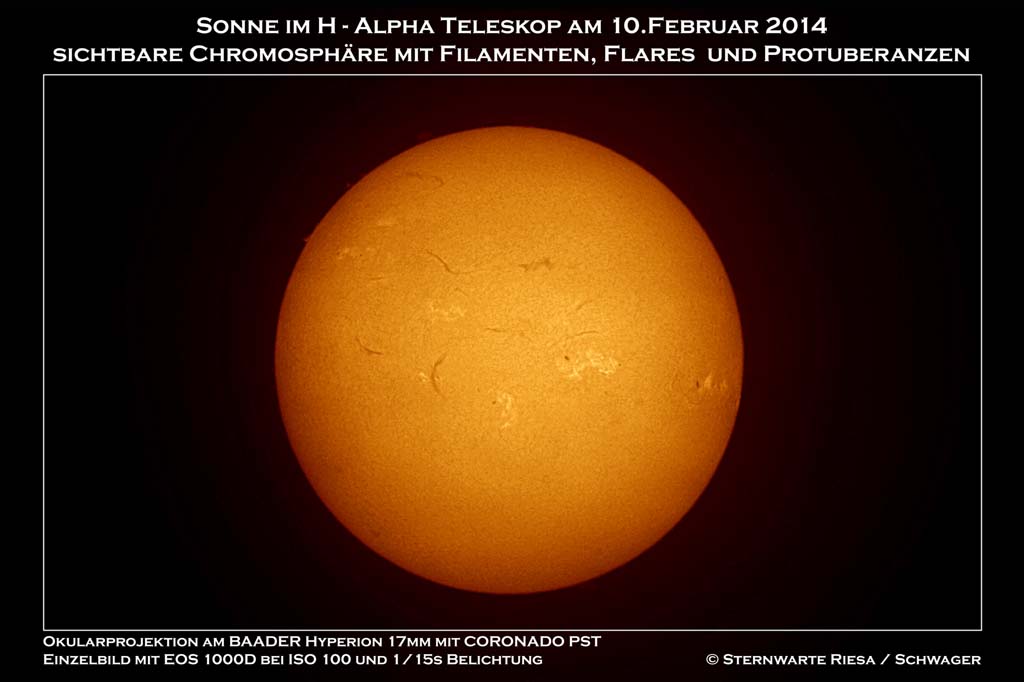
This is our today`s sun in the special hydrogen light sun filter. Present sun shows a lot of details like sunspots or eruptions. Even in this spectral light filter You can see this filaments and flares around the sunspots. Delicius sun observation – try it or visit us.
Child university at the ” Deutsche Bahn AG”
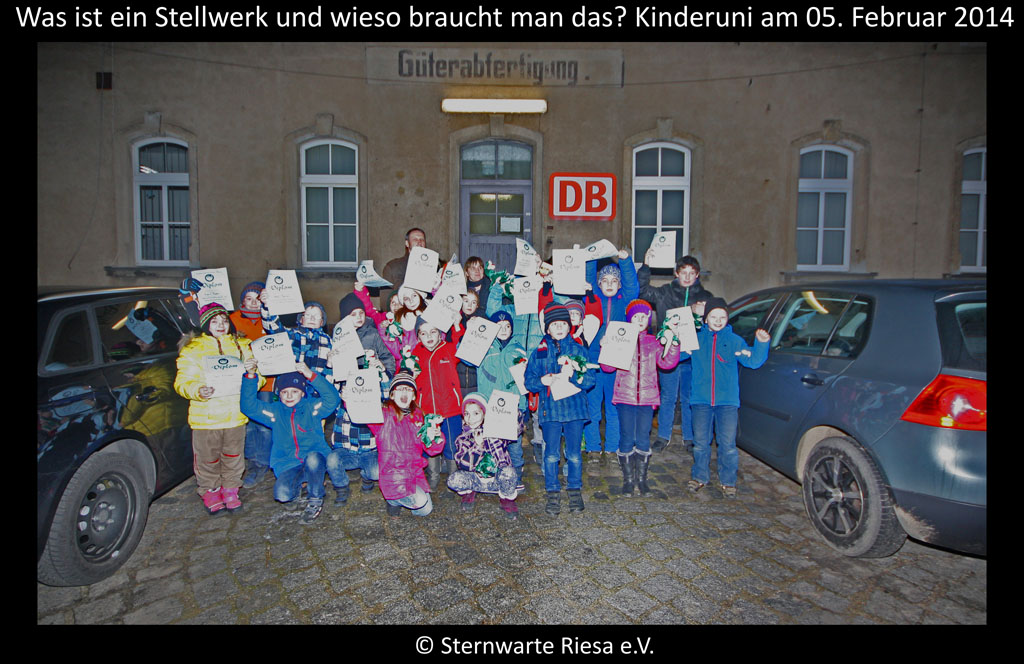
Today the child university was at the “Deutsche Bahn AG”. The children learned a lot about the features and the processes of train traffic.
Sun with a plane
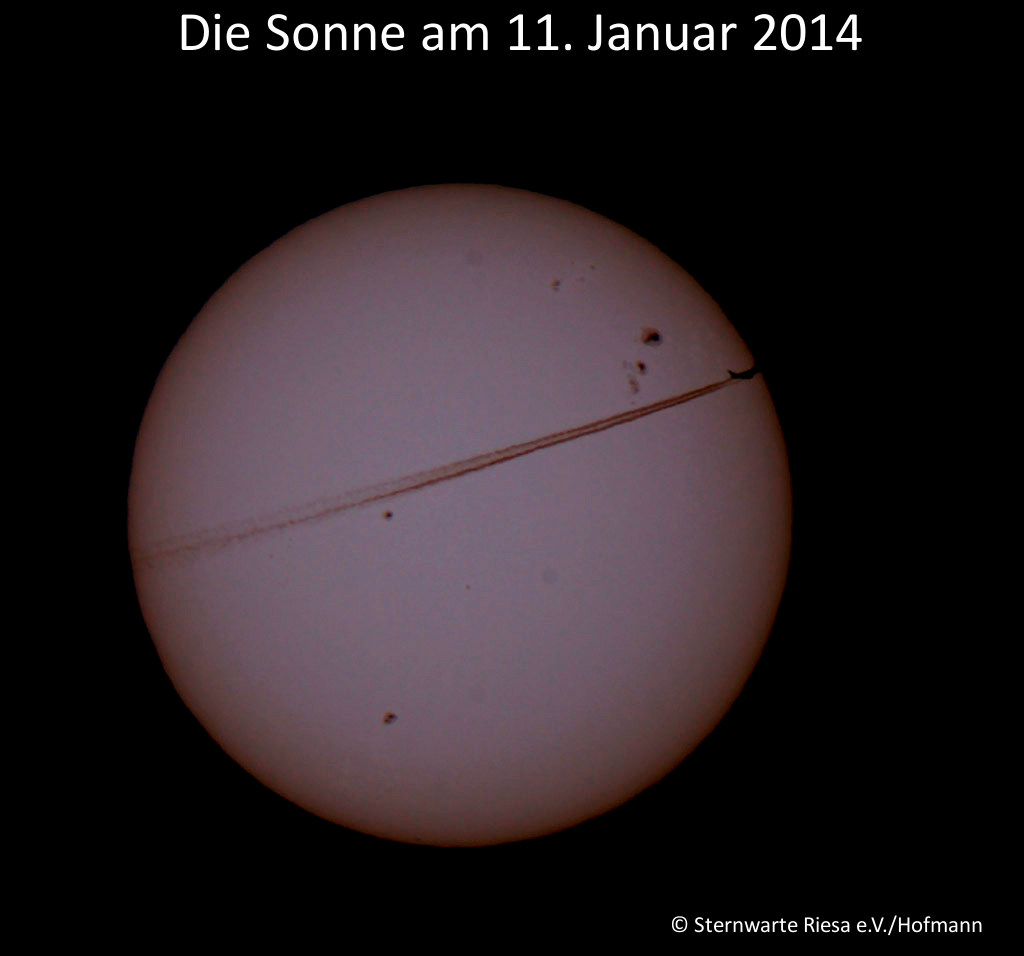
A few days ago there was the giant sunspot group, called AR1944, in the center on the sun surface. Now she has moved and is located at the border of the sun. In a few days they will be no longer visible
Gigant sun spot group
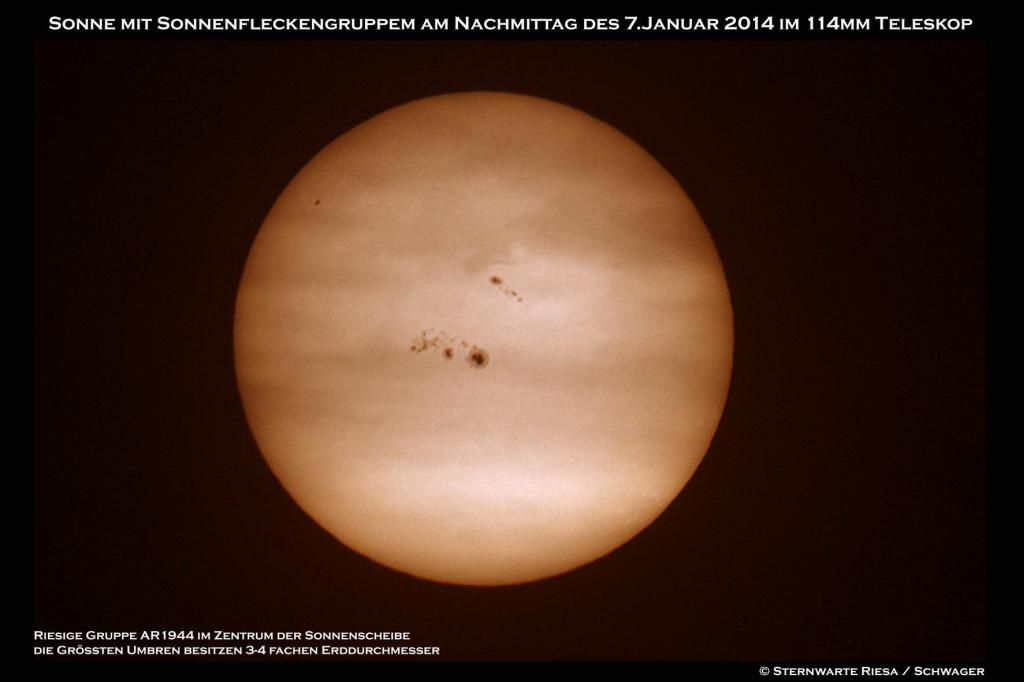
The astronomical observation of the sun, currently generate sensations, because it is the giant sunspot group, called AR1944, on the sun surface. It is one of the largest spots, wich there observed on the sun
Milky Way in Winter time
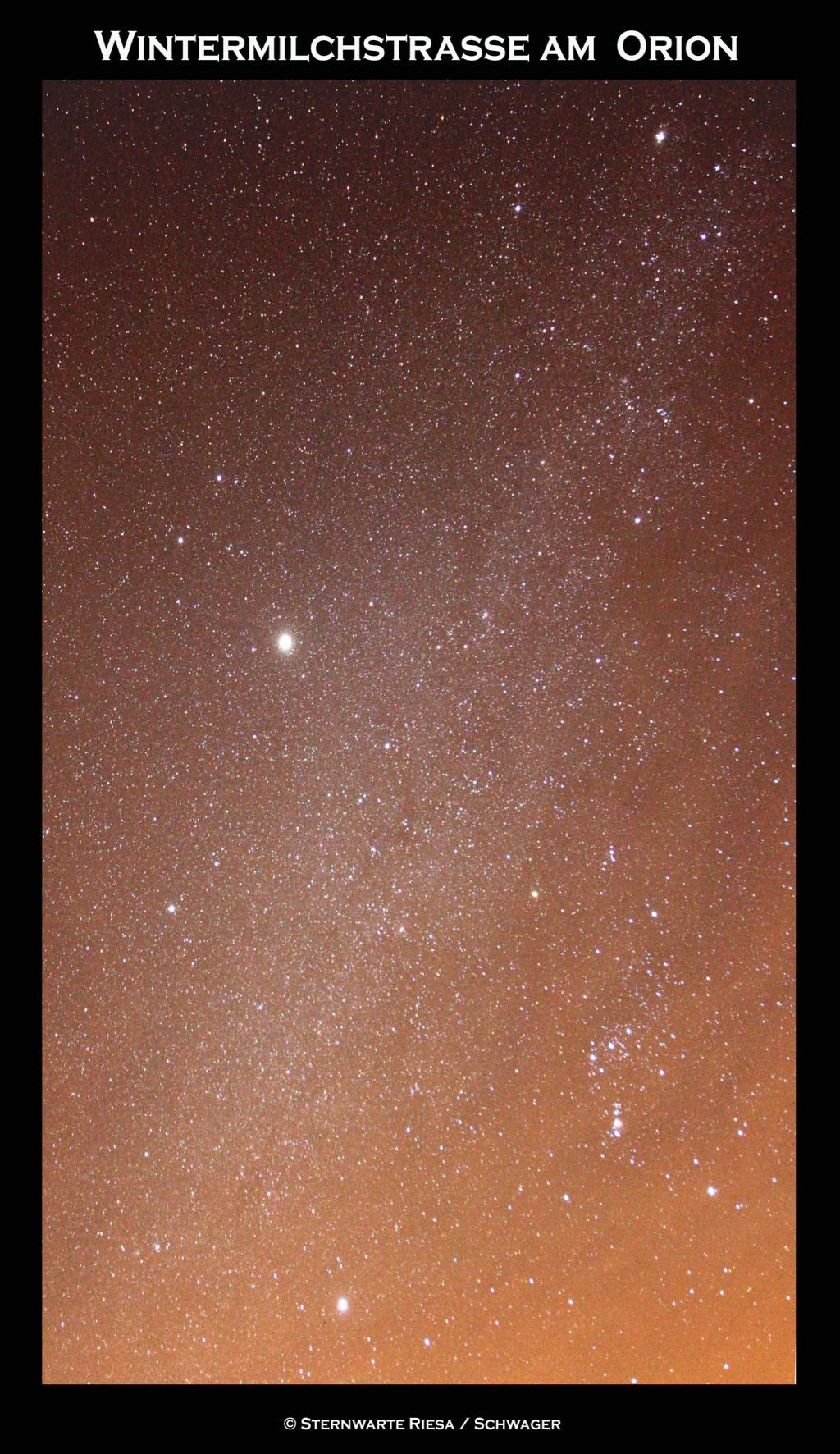
In winter the milkyway is shining at the night sky, like you can see on this picture. At this time of the year it is colder, so the air is very clear and you can see the stars sparkle.
Mammatus Clouds
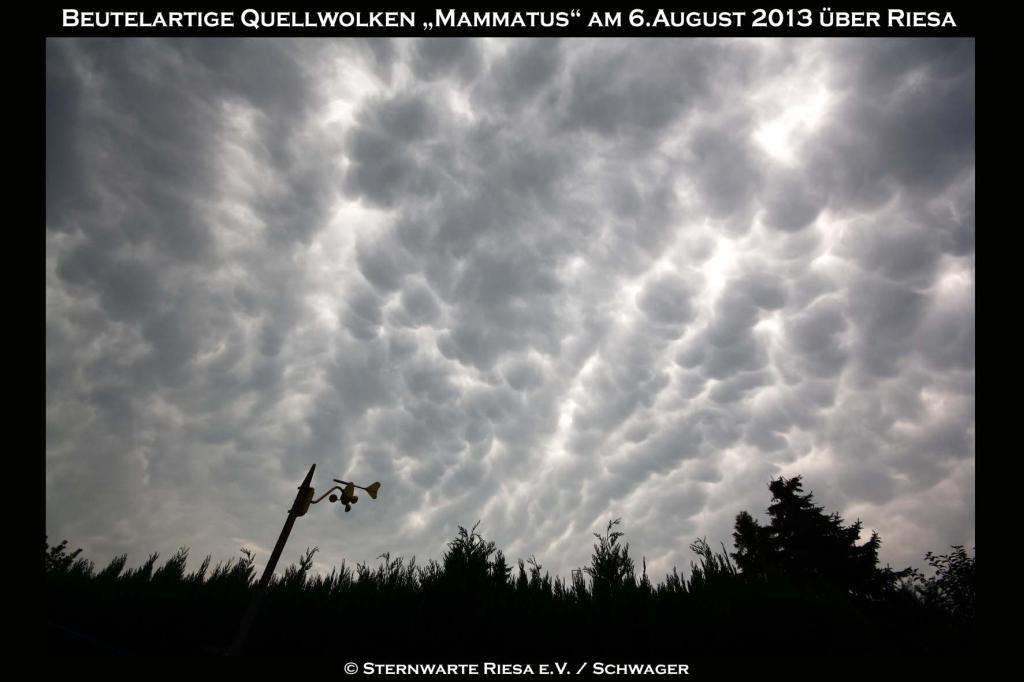
Today you can see in Riesa an impressive cloud formation. These clouds are called mammatus clouds. In winter, they are very seldom. In this most common type of cloud occurs near the equator.
Chrismas market
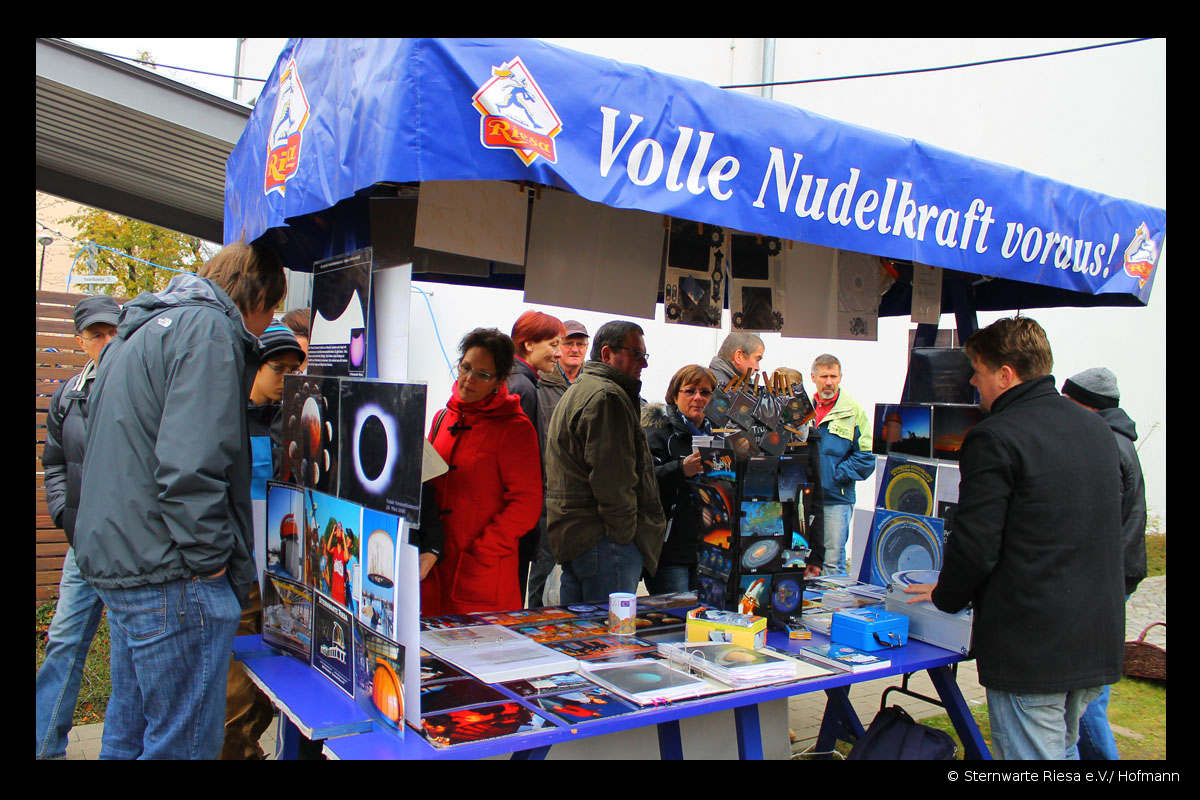
This weekend from 16./17.11.2013 the Teigwaren Riesa made the Christmas market. They were joined by the observatory riesa and offered the guests a safe view through the telescope, with a sunscreen, to the sun. Next, there were also interesting images to various astronomical topics and information about the observatory.
Sun at the telescop
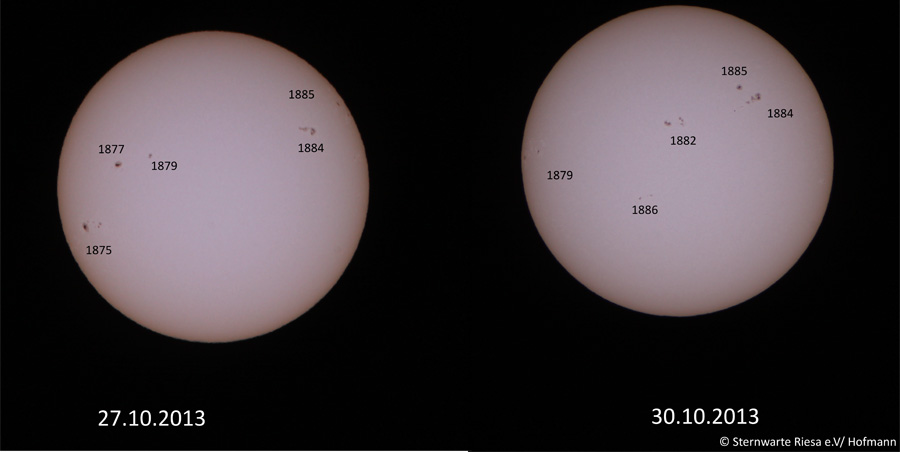
At the end of october the sun was very activ. On this picture you can see very good how the sun spots walk over the surface of the sun. We hope that the weather will be good soon, so that we can get a look on our central star
Observatory Riesa to celebrate a jubilee
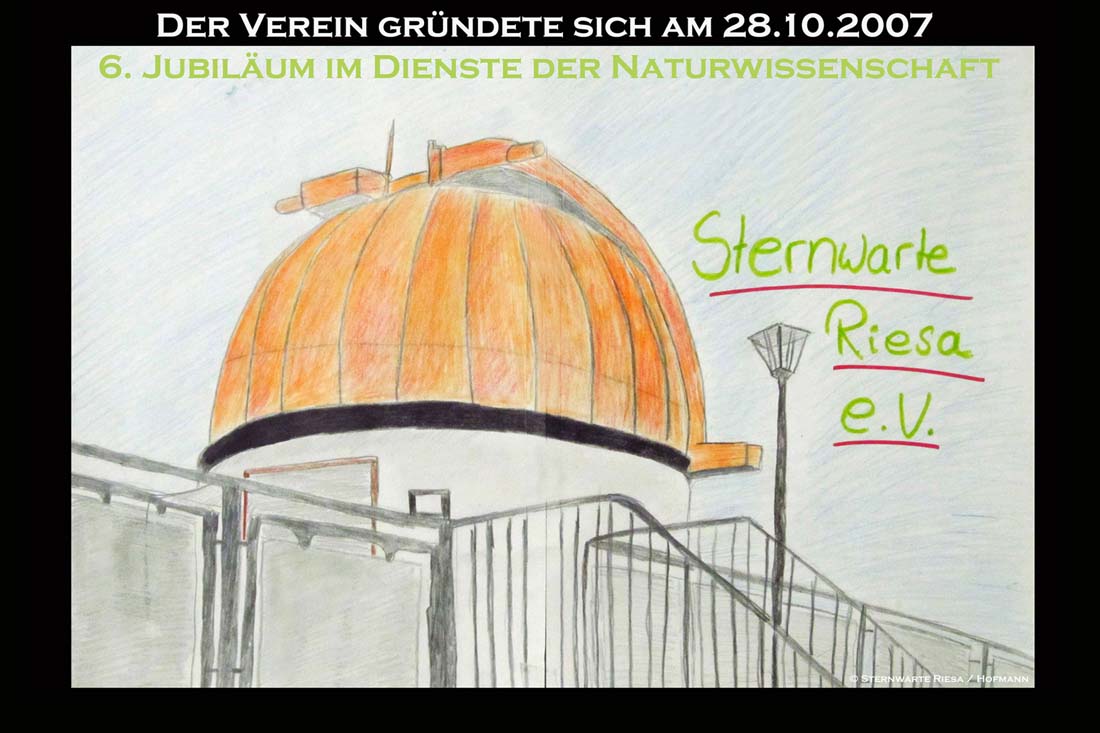
This is the 6th Year of the group around this old observatory. But there are still problems to solve in the future. Not because of enough voluntary people, but for the safety of our institution and the rebuilt of the observatory is still difficult for us. But we get it and try everything to survive. You can help us with Your donation. Happy Birthday “Sternwarte Riesa e.V.”
Frist German in Space
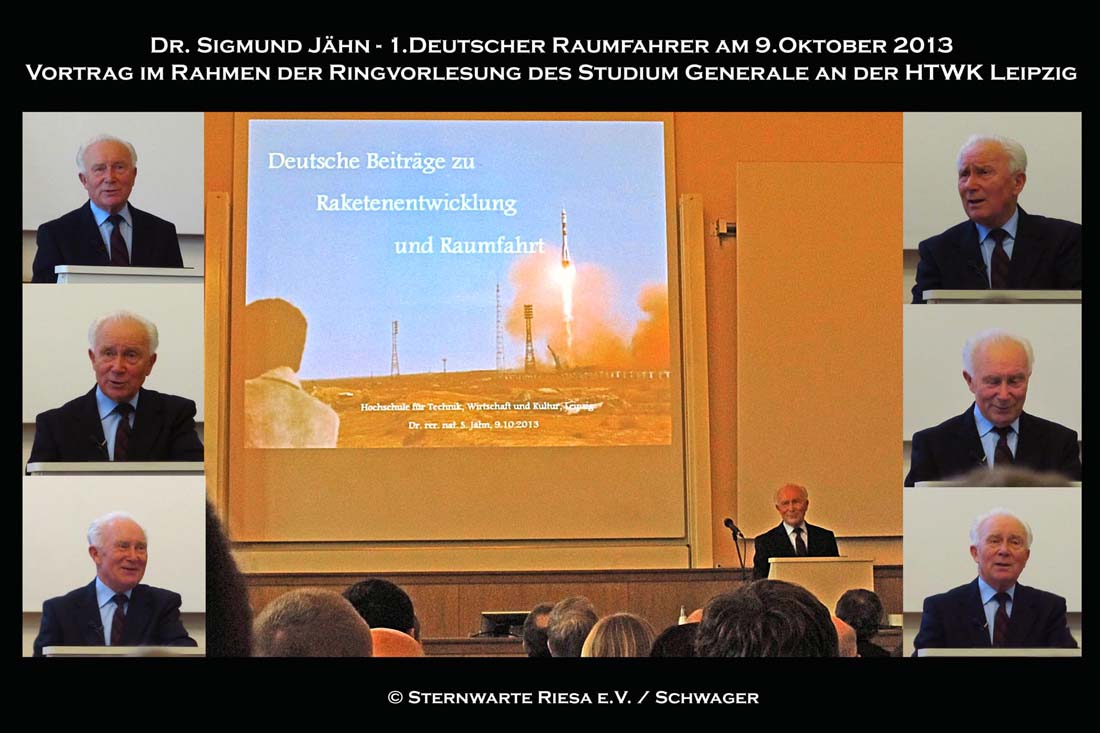
One of the really seldom chances to hear this great hero: Sigmund Jähn, the first German in Space is not very often in public events. But this was one of the events in a saxonian university to meet him. Mr.Jähn is also a special honored member in our observatory and we are very proud to meet him again together with al lot of public. Great speech, fantastic pictures. Thank You Mr.Jähn!
Great Rainbow in Denmark
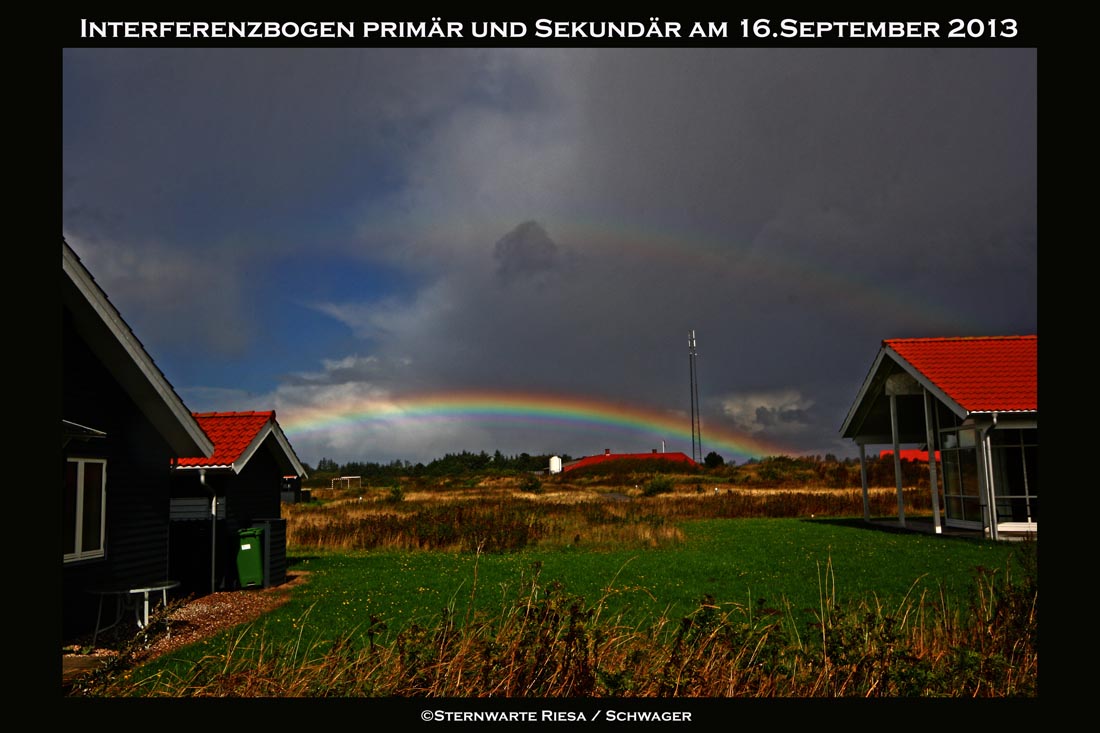
On the theese very rainy days you could see with some luck also the one or other rainbow. Thus immediately 2 specific features(peculiarities) are to be seen in this picture. It concerns an interference curve and this immediately in double implementation. If the sun stands still very high, rainbows are to be seen very close to horizon.
Sundog
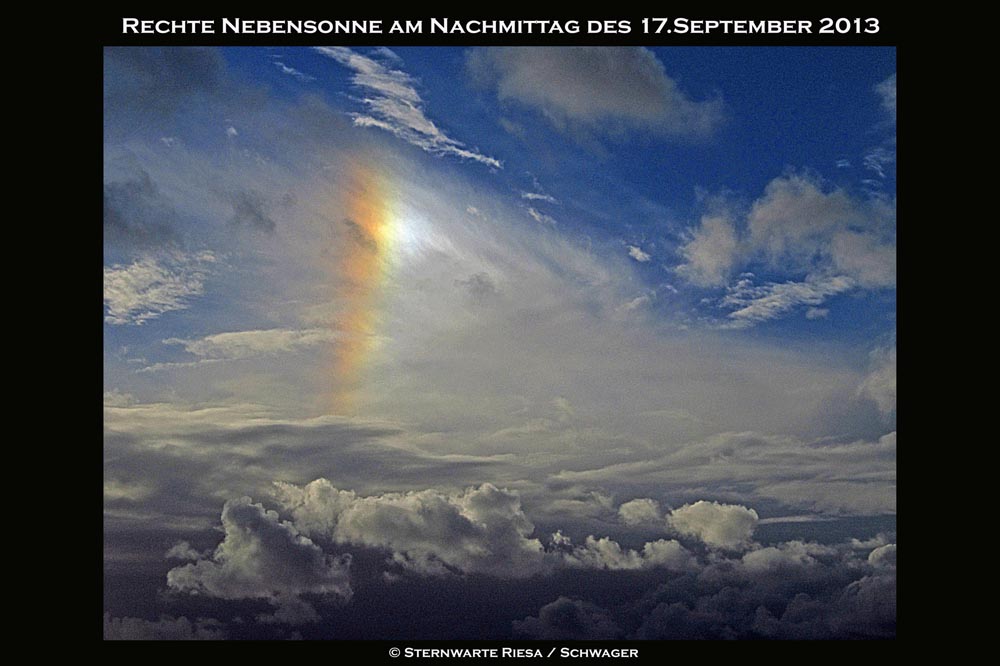
Here You can see a sundog. These lights are a result of sunlight an special ice particle clouds in the higher atmosphere. The colorful light looks like a little part of a rainbow. But it is a sundog, and this one was a really bright one. Sometimes there are two of them, one on the right and the other on the left next to sun. Try to find one.
The dome shines in a new color
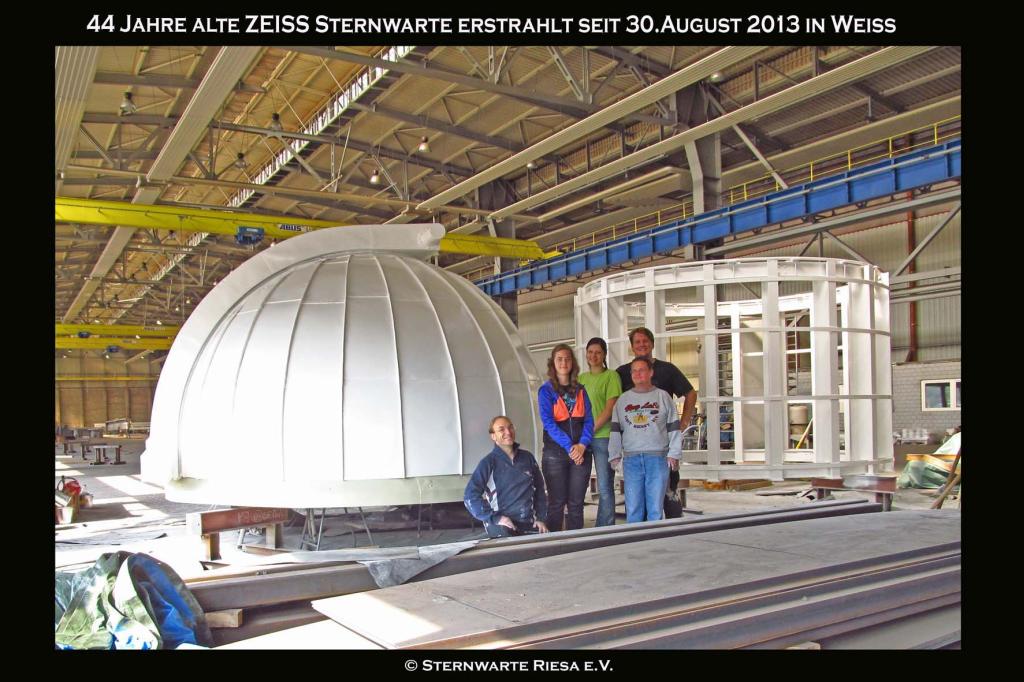
Bevor the end of august, one important step for new life of our 44 years old observatory was finished. After weeks of working with dust, steel and long working days, we finished the new color of our observatorys dome and so it is ready for beginning the second lifetime with us. Thanks for als spnonsors and all the busy people of our astronomy club.
Sun halo and sundog
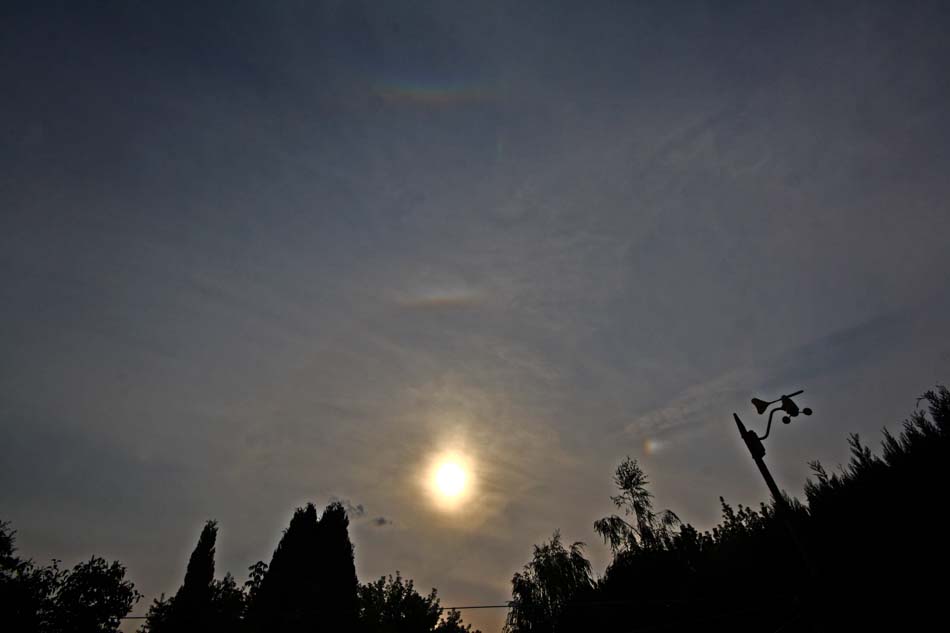
This was a beautiful moment, when the sun was behind some thin cirrus clouds and shows spectecular light reflections in a whole disply. These coloured views we call halo effects and you can see some somedogs and a bright ring of light around the sun. Also a rainbow like bow over you, called circuumzenithal arc. Great show.
Observe ice crystal clouds

At the summer nights we can observe after the sundown or before the sunrise soaringly the ice-crystal clouds which are still illuminated by the sun. With look in the direction of the north the silvery and wave-like clouds can be marvelled at.
Partial lunar eclipse
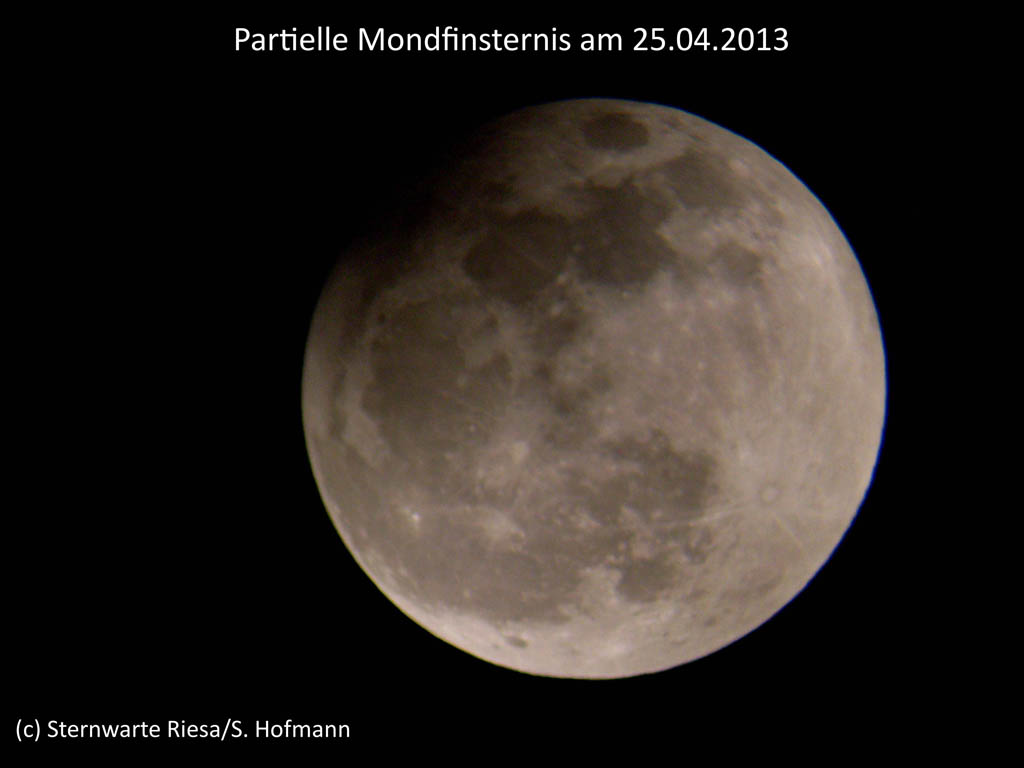
On the 25th of April this year was a partial lunar eclipse. Even if the covering of the moon did not amount more than 2%, every observer could see the darkening in the north the moon clear. To the moonrise the darkness was already in the full way and approx. at 22:07 p.m. the maximum darkening was reached.
Komet C/2011 L4 Panstarrs
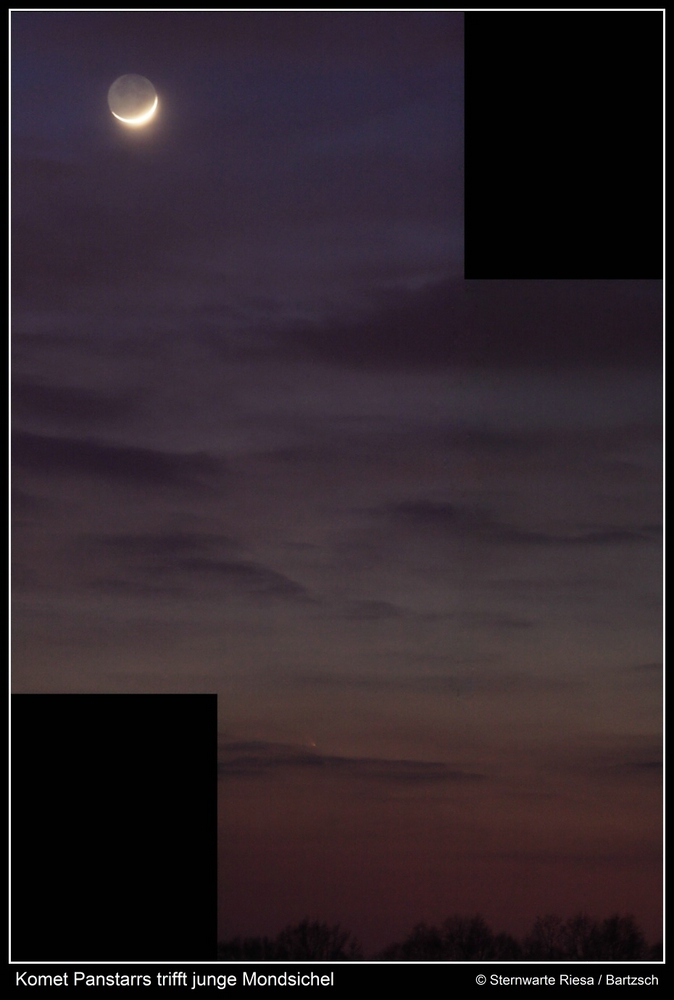
The amateur astronomers of the association observatory of Riesa. managed the sighting to the bright comet C / 2011 L4 Panstarrs. The search was anything but easy(simple) at the beginning, because many clouds obstructed at the beginning the sighting. Bit by bit bigger cloud gaps appeared in the dusk.
The planets mercury and mars
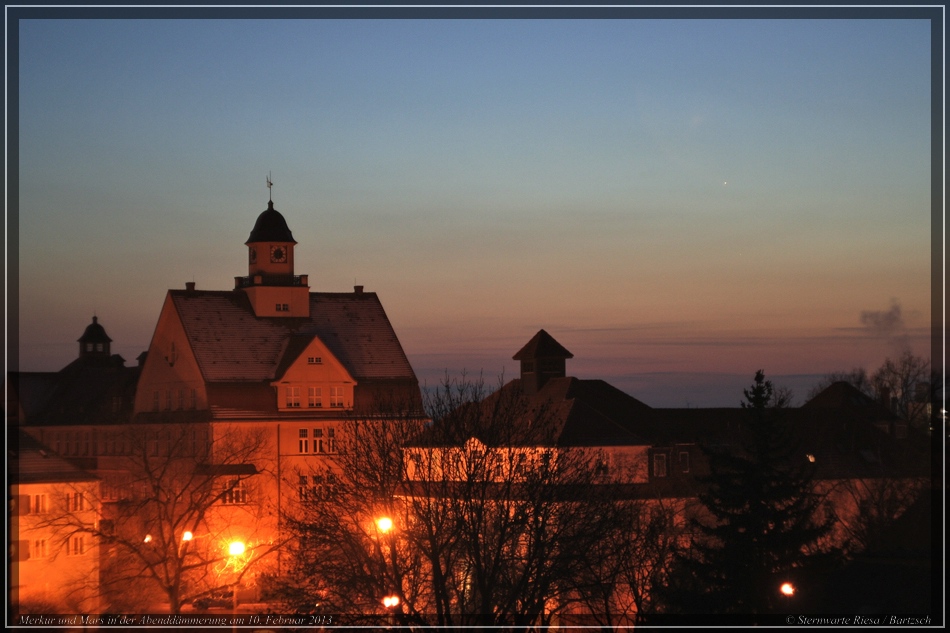
At the moment it is possible in the dusk to see the planets Mercury and Mars. In the time from the 10th to the 26th of February consists furthermore the chance to marvel at at this duet together in the west sky after the sundown.
Wonderful sunrise
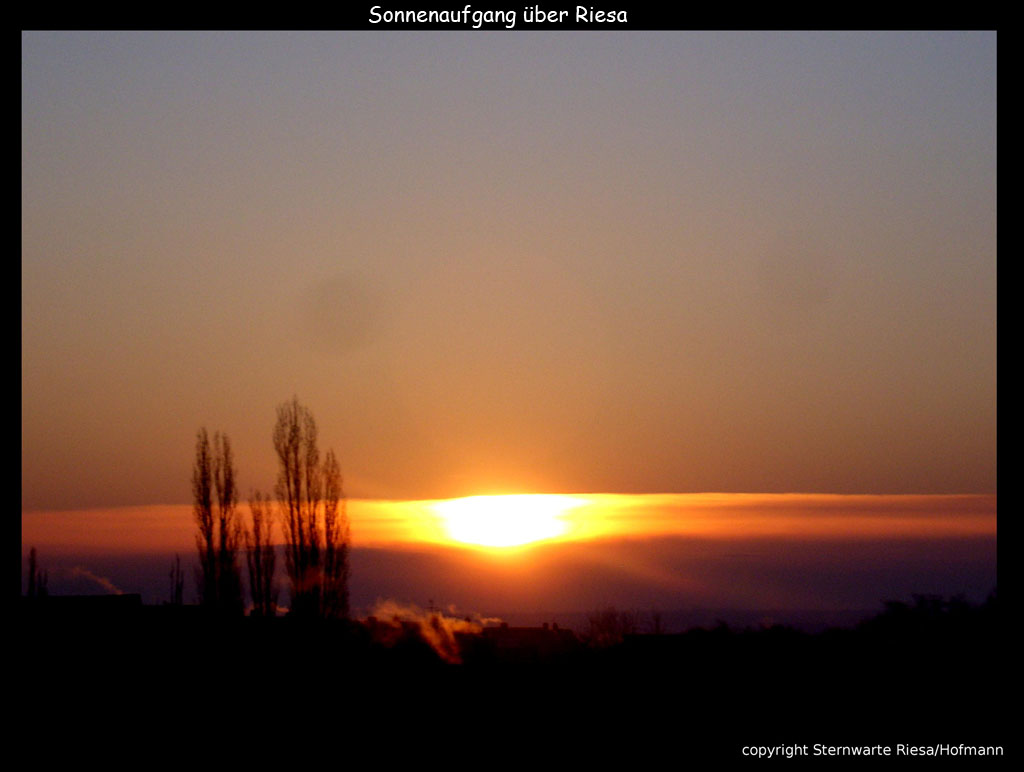
This nice sunrise appeared on the 6th of February, 2013 about the Riesaer Old Town. Now one notices already the days again become longer and nights again shorter. On this day the sun rose 7:50 a.m. CET time.
Sirius – the main star at the constellation big dog

The Sirius is the brightest fixed star and main star in the sign of the zodiac big dog in our winter sky. In the clear next one we see him mostly as a sparkling bright star. The white light is disassembled by the aerial restlessness in different spectral colours. Simply looks these colours as a track if the star walks by the admission picture.
Moon ring and Jupiter
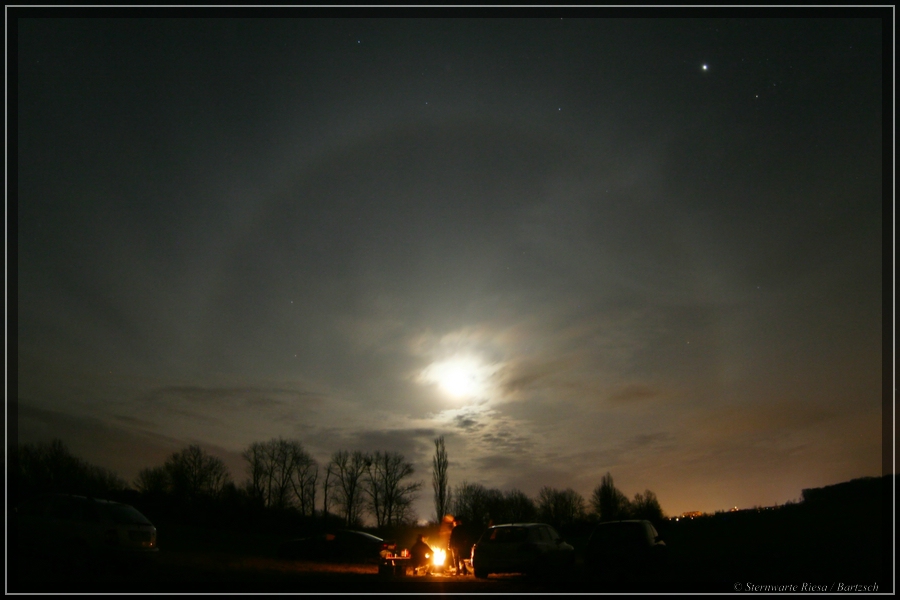
In the comfortable company of the amateur astronomers of the observatory of Riesa could drink mulled wine outside to the airfield in Canitz during the cold night in the campfire. Beside the planet Jupiter 22 degrees Haloring was also to be seen around the moon.
Orion nebula
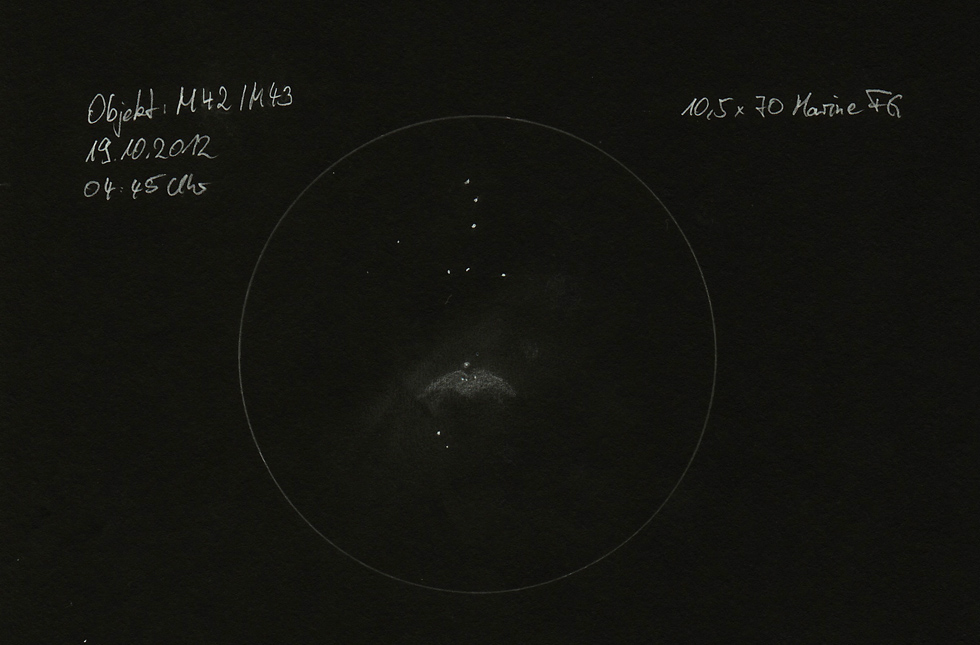
Soon we can be observed at the nights without moon of the Orionnebel as one of the best known and nicest objects. Under three belt stars of the big sign of the zodiac Orion the bright Deep Sky object is to be found. This drawing shows the binoculars sight with 10.5-fold enlargement
Moonrise

In this evening one could see in the nice weather not only the full moon rising, but also observe the shadow throw of a cloud in the direction of moon. Perspektiv partly there runs this shade from the cloud going about the sky up to the Sonnengegenpunkt.
Meteor steam Perseiden
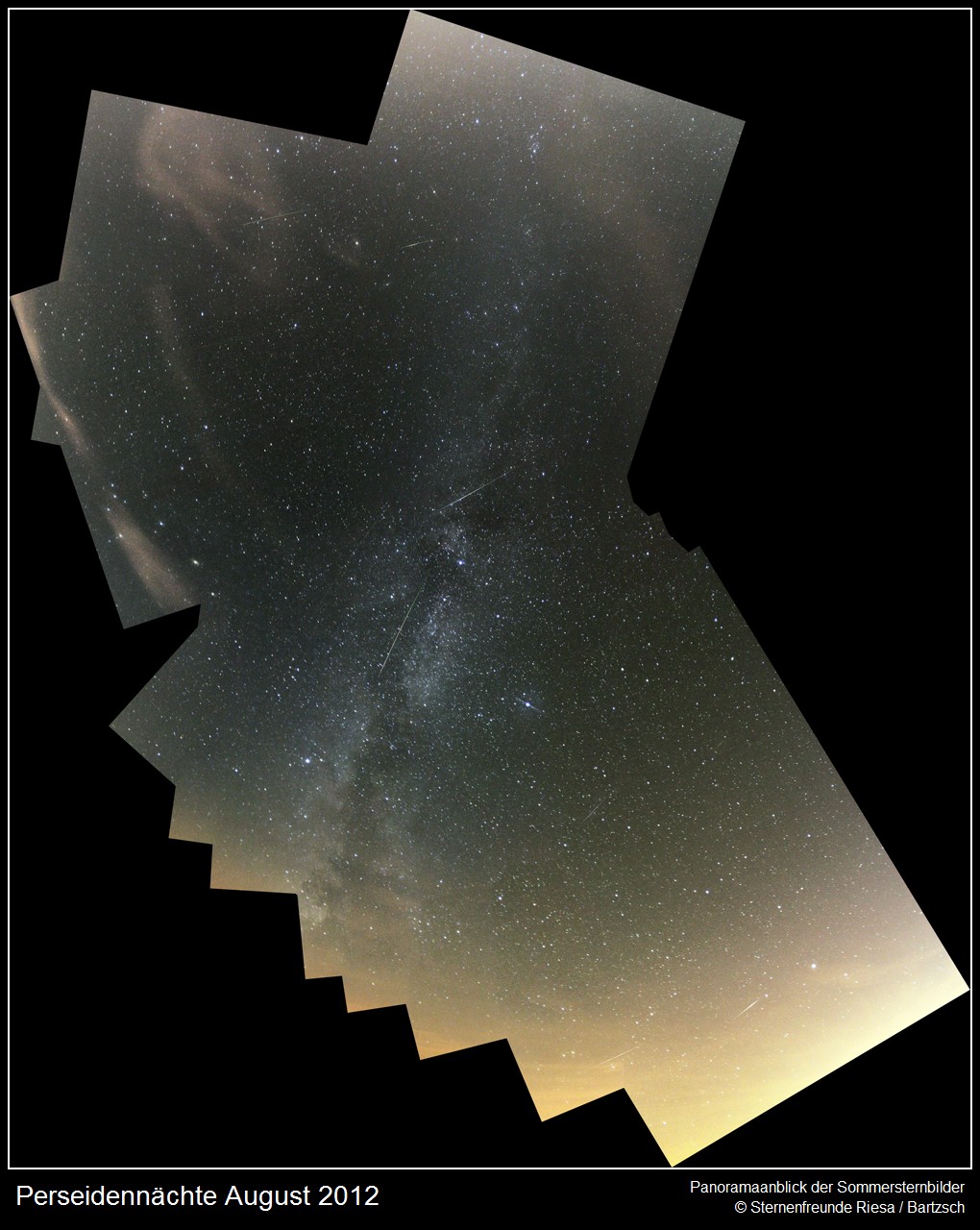
Since some nights the members of the observatory of Riesa observe the meteor stream Perseiden. With the help of the collage the track allows to trace back of some shooting stars to the Radiant and this schenbarer origin lies in the sign of the zodiac Perseus.
Meteor nights at the airfield in canitz

This is the first picture of the Perseids this year. It was taken at our first meteor observation night in summer with a fisheye camera near Riesa. It was a brilliant fireball in the sky and all the guests were really impressed of this bright meteor. Until august 18th we will count meteors from 10p.m. every day. Join us!
Red rainbow
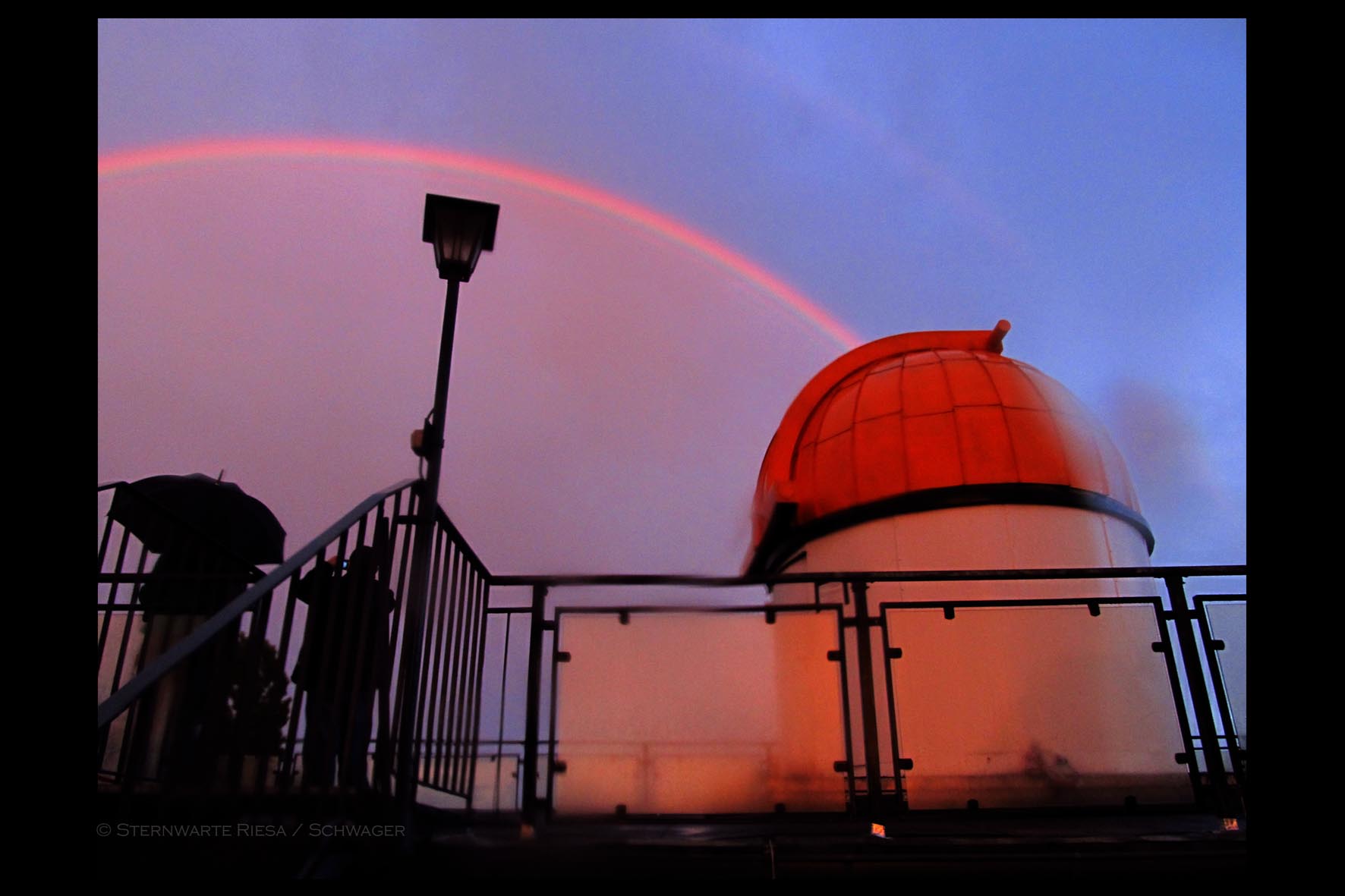
This is a special type of a rainbow. This red rainbow was photographed shortly befor sunset in the evening, when the red rays of the sunlight are the bringhtest in the sky. If there is rain like in this moment last evening, than a red rainbow is possible to see. Nice colours.
NLC Cloud
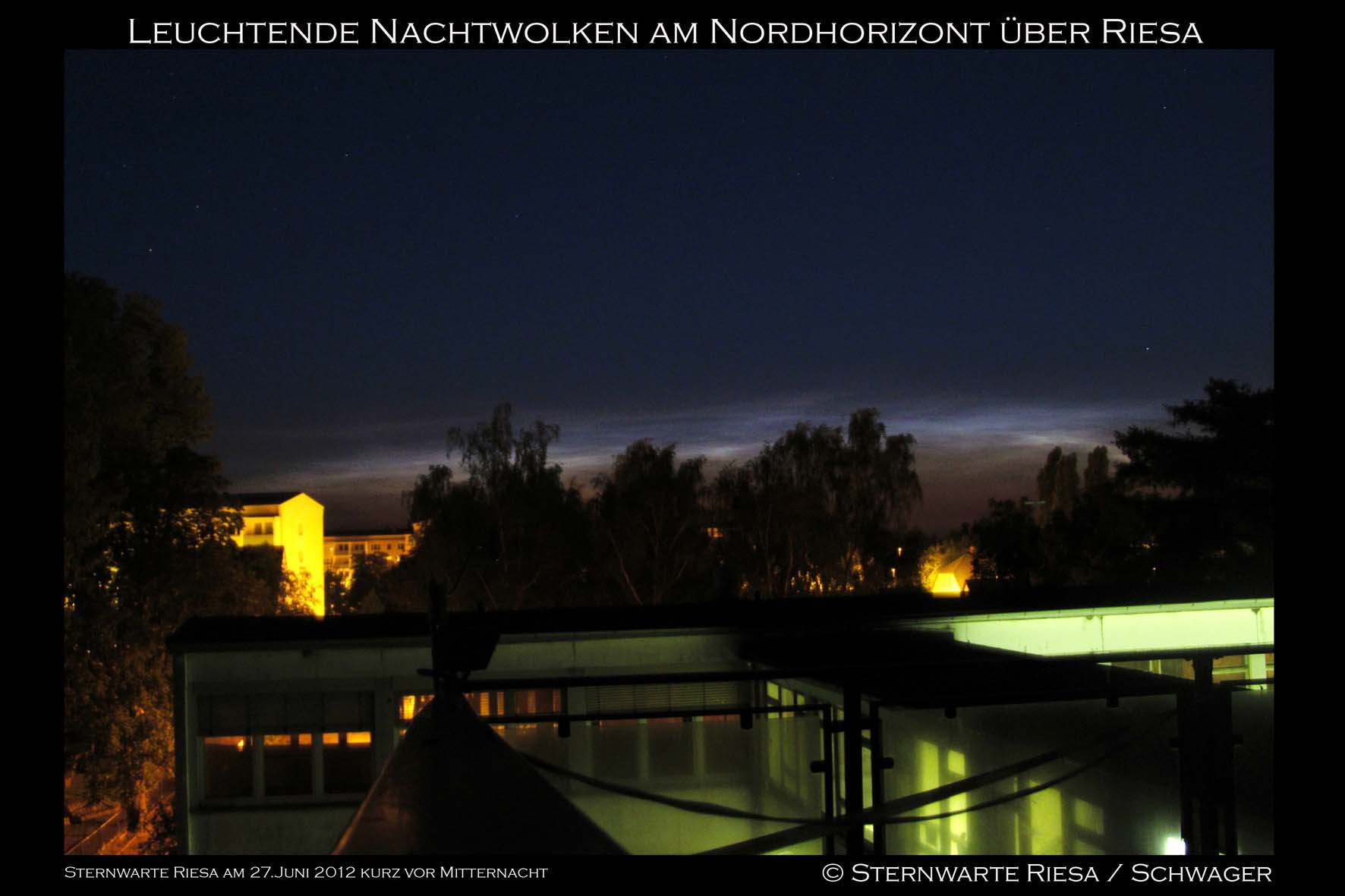
This is a `NLC Cloud` in the summer night sky. These clouds are locatet so high in the atmosphere, that sunlight can even reach them at night. So you can see these clouds together with stars in a bright silver, white or light coloured structure deep in the northern part of the nightsky.









